Paul van Yperen's Blog, page 35
October 21, 2024
Happy birthday, Catherine Deneuve!
Today it's the 81h birthday of elegant Catherine Deneuve (1943). She is an icon of French cinema who has graced the screen for more than six decades. She gained recognition in the 1960s for her portrayal of cool, mysterious beauties in classic films by directors like Luis Buñuel, Roman Polanski and François Truffaut. Apart from being a great actress, she is also an archetype for Gallic beauty. From 1985 to 1989, she succeeded Brigitte Bardot as the model for the national symbol Marianne, seen on French coins and stamps. Since then she had new successes with such directors as Lars von Trier and François Ozon. Joyeux anniversaire, Mme. Deneuve!
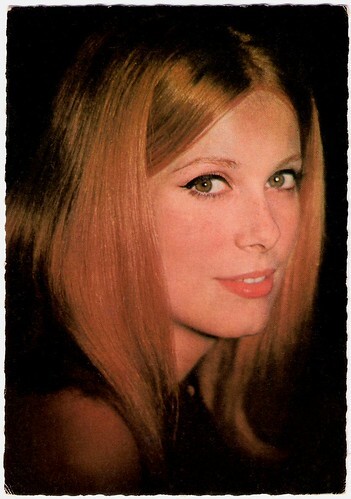
French postcard by E.D.U.G., no. 378. Photo: Sam Lévin.
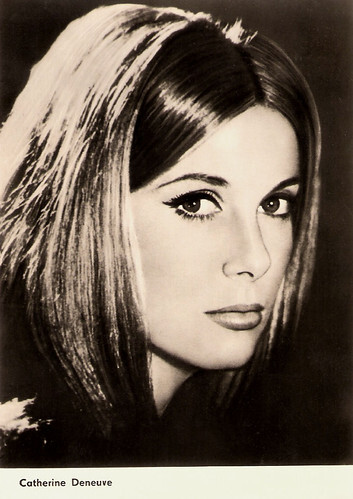
East-German postcard by VEB Progress Film-Vertrieb, Berlin, no. 2522, 1965. Retail price: 0,20 MDN. Photo: Sam Lévin.
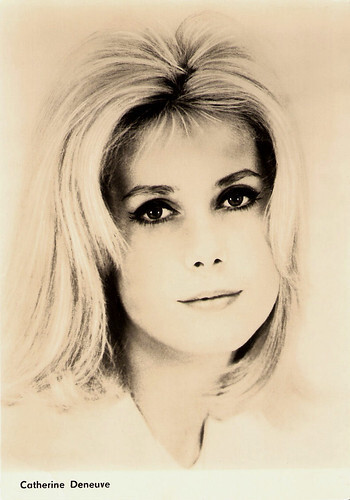
East-German postcard by VEB Progress Film-Vertrieb, Berlin, no. 2533, 1966. Retail price: 0,20 MDN.
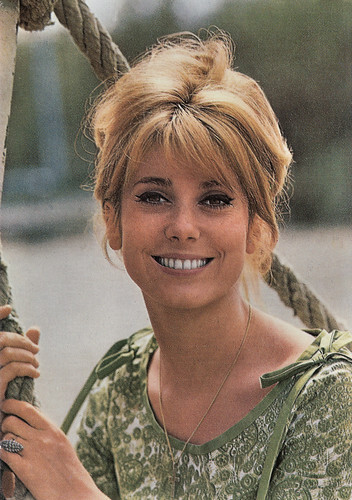
French postcard by PSG, no. 1410.
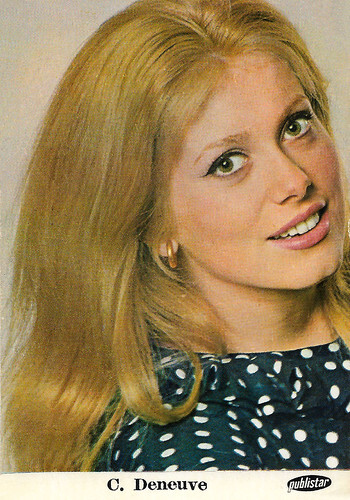
French collector card by Publistar. Photo: Patrick de Mervellec.
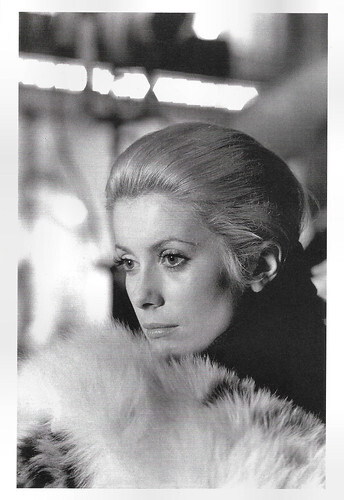
French postcard by Éditions Hazan, Paris, in the Collection Magie Noire, no. 6435, 1994. Photo: Raymond Depardon / Magnum Photos. Catherine Deneuve in La chamade/Heartbeat (Alain Cavalier, 1968).
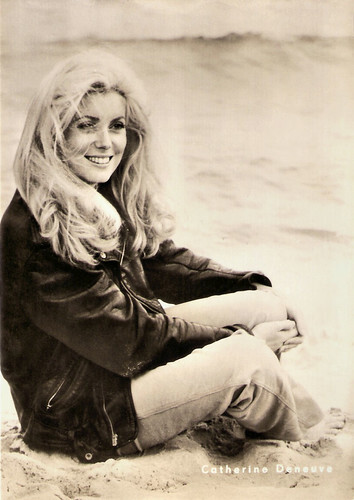
East German postcard by VEB Progress Film-Vertrieb, Berlin, no. 3/71.
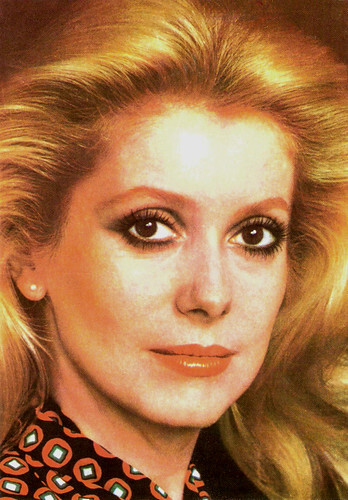
Romanian postcard by Casa Filmului Acin.
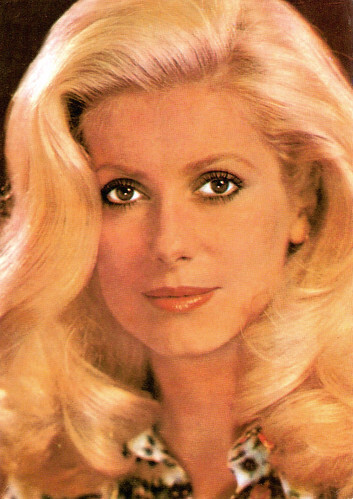
Romanian postcard by Casa Filmului Acin, no. 568.
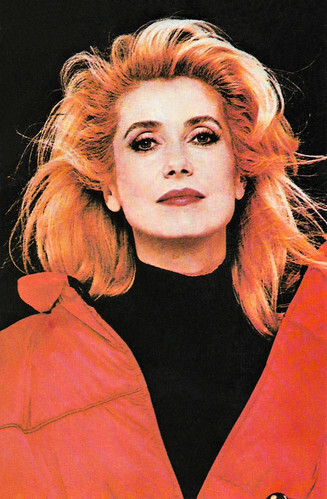
Romanian postcard by InterCONTEMPress.
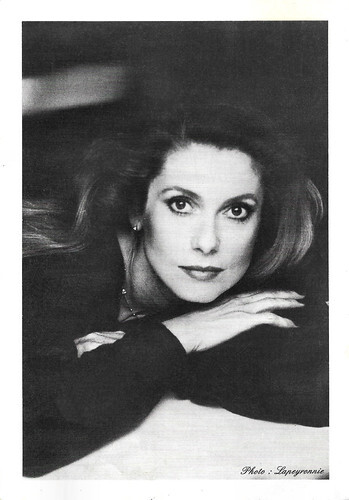
Vintage card. Photo: Lapeyronnie.
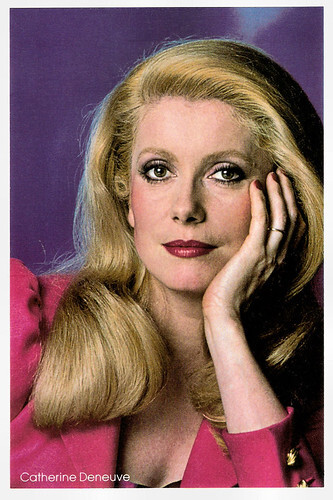
American postcard by The American Postcard Co., 1981, no. 285. Photo: Douglas Kirkland / Contact.
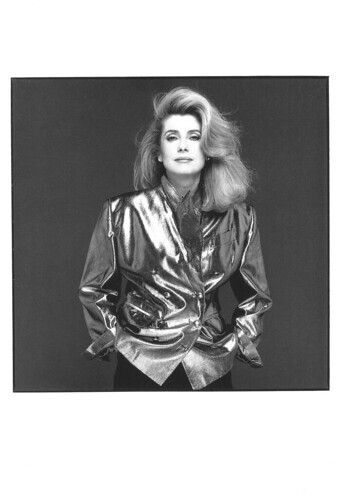
Swiss postcard by News Productions, Baulmes, no. 55950. Photo: Bettina Rheims / Sygma. Caption: Catherine Deneuve, Paris, 1988.
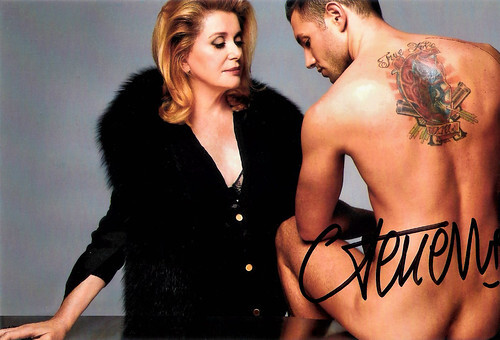
French autograph card.
And check out our other Catherine Deneuve posts.

French postcard by E.D.U.G., no. 378. Photo: Sam Lévin.

East-German postcard by VEB Progress Film-Vertrieb, Berlin, no. 2522, 1965. Retail price: 0,20 MDN. Photo: Sam Lévin.

East-German postcard by VEB Progress Film-Vertrieb, Berlin, no. 2533, 1966. Retail price: 0,20 MDN.

French postcard by PSG, no. 1410.

French collector card by Publistar. Photo: Patrick de Mervellec.

French postcard by Éditions Hazan, Paris, in the Collection Magie Noire, no. 6435, 1994. Photo: Raymond Depardon / Magnum Photos. Catherine Deneuve in La chamade/Heartbeat (Alain Cavalier, 1968).

East German postcard by VEB Progress Film-Vertrieb, Berlin, no. 3/71.

Romanian postcard by Casa Filmului Acin.

Romanian postcard by Casa Filmului Acin, no. 568.

Romanian postcard by InterCONTEMPress.

Vintage card. Photo: Lapeyronnie.

American postcard by The American Postcard Co., 1981, no. 285. Photo: Douglas Kirkland / Contact.

Swiss postcard by News Productions, Baulmes, no. 55950. Photo: Bettina Rheims / Sygma. Caption: Catherine Deneuve, Paris, 1988.

French autograph card.
And check out our other Catherine Deneuve posts.
Published on October 21, 2024 22:00
October 20, 2024
House of the Flying Daggers (2004)
Zhang Yimou conceived the story of the Chinese film Shi mian mai fu/House of the Flying Daggers (Yimou Zhang, 2004) in the late 1990s as a companion to his action film Ying xiong/Hero (Zhang Yimou, 2002). House of the Flying Daggers is more of a love story than purely a martial arts film. It elegantly combines excitement, romance and astonishing physical beauty.
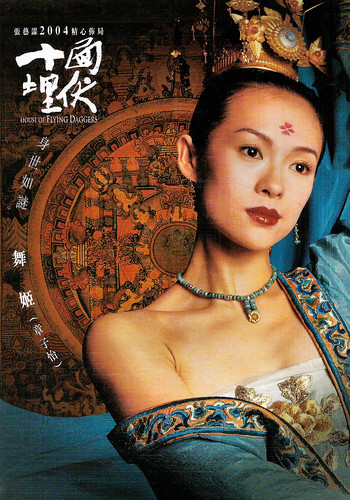
Australian freecard by Art Cards, no. 646, 2004. Zhang Ziyi as Mei in Shi mian mai fu/House of the Flying Daggers (Zhang Yimou, 2004).
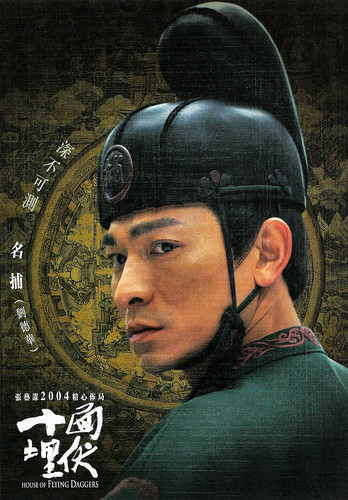
Australian freecard by Art Cards, no. 647, 2004. Andy Lau as Leo in Shi mian mai fu/House of the Flying Daggers (Zhang Yimou, 2004).

Australian freecard by Art Cards, no. 648, 2004. Andy Lau as Leo, Zhang Ziyi as Mei, and Takeshi Kaneshiro as Jin in Shi mian mai fu/House of the Flying Daggers (Zhang Yimou, 2004).
A beautiful woman who brings woe to two men
Shi mian mai fu/House of the Flying Daggers (Zhang Yimou, 2004) takes place in 859 AD. The once-mighty Tang Dynasty in China is in decline. The emperor is weak and incompetent. His corrupt government no longer controls the land.
Unrest sweeps the country. A secret organisation called 'The House of the Flying Daggers' rises and opposes the government. Two police officers, Leo (Andy Lau) and Jin (Takeshi Kaneshiro) are ordered to kill the group leader within ten days, an impossible task given no one even knows the leader's identity.
When government soldiers raid a brothel, they find the blind dancer Mei (Zhang Ziyi). She initially appears to be the daughter of the assassinated leader of the 'Flying Daggers'.
Leo sends Jin to investigate the beautiful Mei. Leo arrests Mei, only to have Jin break her free in a plot to gain her trust and lead the police to the new leader of the secret organisation. But soon it seems Mei and Jin start to feel more for each other. However, they are from different camps.
Zhang Yimou borrowed the theme of a beautiful woman who brings woe to two men from a famous poem written by the Han Dynasty poet Li Yannian.
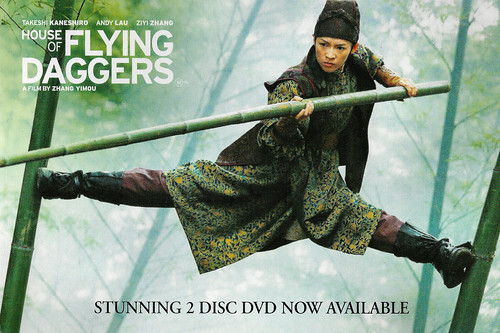
Australian freecard by Avant Cards, no. 9671, 2005. Zhang Ziyi as Mei in Shi mian mai fu/House of the Flying Daggers (Zhang Yimou, 2004).
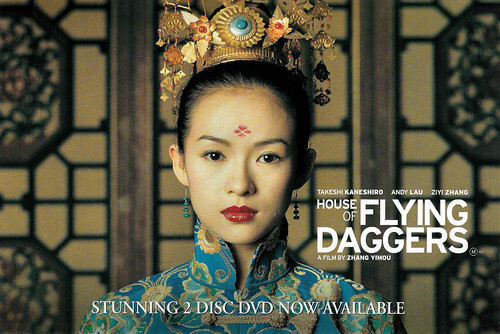
Australian freecard by AvantCard, no. 9673. Photo: Universal / Focus Features. Zhang Ziyi as Mei in Shi mian mai fu/House of the Flying Daggers (Zhang Yimou, 2004).
Focus just on the visuals - the film is so good to look at
Most of Shi mian mai fu/House of the Flying Daggers (Zhang Yimou, 2004) was shot in Ukraine's Carpathian Mountains (the Hutsul Region National Park), such as the scenes in the snow or birch forests.
The bamboo forest sequences were filmed in China at Yongchuan, Sichuan Province, in the bamboo forests of Tea Mountain and Bamboo Sea Scenery Park, near the city of Chongqing. The cast and production team spent 70 days on location from September to October 2003 and were largely based in Kosiv.
The climactic fight scene was filmed in Ukraine in October. It snowed so early that it caught the filmmakers by surprise. They decided to change the script and the film so that it would appear almost as if this epic battle began during the fall and ended during winter.
Director Yimou Zhang or Zhang Yimou later said that despite the unpredictable weather forcing the alterations, he had achieved the desired effect and was very happy with the final result. The early snowfall set the perfect tone and highlighted the blood spilt on the snow.
The film reportedly received a 20-minute standing ovation when it debuted in May at the 2004 Cannes Film Festival to enthusiastic receptions. Roger Ebert: "Forget about the plot, the characters, the intrigue, which are all splendid in House of Flying Daggers, and focus just on the visuals. The film is so good to look at and listen to that, as with some operas, the story is almost beside the point, serving primarily to get us from one spectacular scene to another."
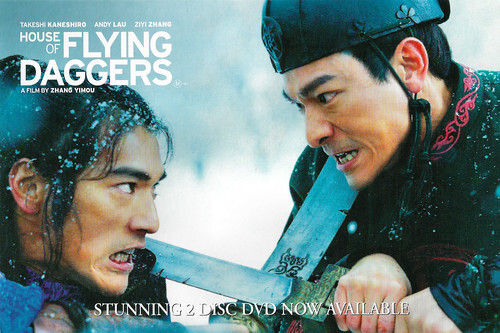
Australian freecard by Avant Cards, no. 9674, 2005. Andy Lau as Leo and Takeshi Kaneshiro as Jin in Shi mian mai fu/House of the Flying Daggers (Zhang Yimou, 2004).
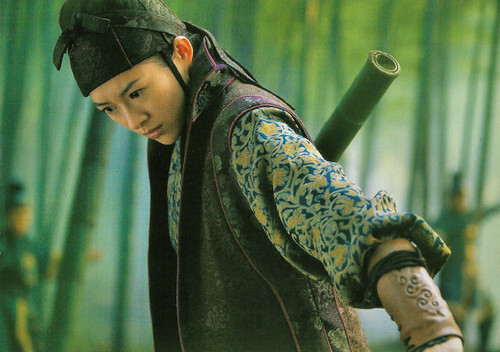
British freecard by Picturehouse Cinemas. Zhang Ziyi as Mei in Shi mian mai fu/House of the Flying Daggers (Zhang Yimou, 2004).

Australian freecard by Avant Cards, no. 9676, 2005. Takeshi Kaneshiro as Jin in Shi mian mai fu/House of the Flying Daggers (Zhang Yimou, 2004).
Sources: Roger Ebert (Roger Ebert.com), Wikipedia (Dutch and English) and IMDb.

Australian freecard by Art Cards, no. 646, 2004. Zhang Ziyi as Mei in Shi mian mai fu/House of the Flying Daggers (Zhang Yimou, 2004).

Australian freecard by Art Cards, no. 647, 2004. Andy Lau as Leo in Shi mian mai fu/House of the Flying Daggers (Zhang Yimou, 2004).

Australian freecard by Art Cards, no. 648, 2004. Andy Lau as Leo, Zhang Ziyi as Mei, and Takeshi Kaneshiro as Jin in Shi mian mai fu/House of the Flying Daggers (Zhang Yimou, 2004).
A beautiful woman who brings woe to two men
Shi mian mai fu/House of the Flying Daggers (Zhang Yimou, 2004) takes place in 859 AD. The once-mighty Tang Dynasty in China is in decline. The emperor is weak and incompetent. His corrupt government no longer controls the land.
Unrest sweeps the country. A secret organisation called 'The House of the Flying Daggers' rises and opposes the government. Two police officers, Leo (Andy Lau) and Jin (Takeshi Kaneshiro) are ordered to kill the group leader within ten days, an impossible task given no one even knows the leader's identity.
When government soldiers raid a brothel, they find the blind dancer Mei (Zhang Ziyi). She initially appears to be the daughter of the assassinated leader of the 'Flying Daggers'.
Leo sends Jin to investigate the beautiful Mei. Leo arrests Mei, only to have Jin break her free in a plot to gain her trust and lead the police to the new leader of the secret organisation. But soon it seems Mei and Jin start to feel more for each other. However, they are from different camps.
Zhang Yimou borrowed the theme of a beautiful woman who brings woe to two men from a famous poem written by the Han Dynasty poet Li Yannian.

Australian freecard by Avant Cards, no. 9671, 2005. Zhang Ziyi as Mei in Shi mian mai fu/House of the Flying Daggers (Zhang Yimou, 2004).

Australian freecard by AvantCard, no. 9673. Photo: Universal / Focus Features. Zhang Ziyi as Mei in Shi mian mai fu/House of the Flying Daggers (Zhang Yimou, 2004).
Focus just on the visuals - the film is so good to look at
Most of Shi mian mai fu/House of the Flying Daggers (Zhang Yimou, 2004) was shot in Ukraine's Carpathian Mountains (the Hutsul Region National Park), such as the scenes in the snow or birch forests.
The bamboo forest sequences were filmed in China at Yongchuan, Sichuan Province, in the bamboo forests of Tea Mountain and Bamboo Sea Scenery Park, near the city of Chongqing. The cast and production team spent 70 days on location from September to October 2003 and were largely based in Kosiv.
The climactic fight scene was filmed in Ukraine in October. It snowed so early that it caught the filmmakers by surprise. They decided to change the script and the film so that it would appear almost as if this epic battle began during the fall and ended during winter.
Director Yimou Zhang or Zhang Yimou later said that despite the unpredictable weather forcing the alterations, he had achieved the desired effect and was very happy with the final result. The early snowfall set the perfect tone and highlighted the blood spilt on the snow.
The film reportedly received a 20-minute standing ovation when it debuted in May at the 2004 Cannes Film Festival to enthusiastic receptions. Roger Ebert: "Forget about the plot, the characters, the intrigue, which are all splendid in House of Flying Daggers, and focus just on the visuals. The film is so good to look at and listen to that, as with some operas, the story is almost beside the point, serving primarily to get us from one spectacular scene to another."

Australian freecard by Avant Cards, no. 9674, 2005. Andy Lau as Leo and Takeshi Kaneshiro as Jin in Shi mian mai fu/House of the Flying Daggers (Zhang Yimou, 2004).

British freecard by Picturehouse Cinemas. Zhang Ziyi as Mei in Shi mian mai fu/House of the Flying Daggers (Zhang Yimou, 2004).

Australian freecard by Avant Cards, no. 9676, 2005. Takeshi Kaneshiro as Jin in Shi mian mai fu/House of the Flying Daggers (Zhang Yimou, 2004).
Sources: Roger Ebert (Roger Ebert.com), Wikipedia (Dutch and English) and IMDb.
Published on October 20, 2024 22:00
October 19, 2024
Franca Bettoia
Italian actress Franca Bettoia (1936) passed away on 13 September 2024. She starred in several Italian films of the 1950s and 1960s. Bettoia is best known for the chilling Sci-Fi/Horror tale and cult film L'Ultimo uomo della Terra/The Last Man on Earth (1964) and as the widow of Ugo Tognazzi. She was 88.
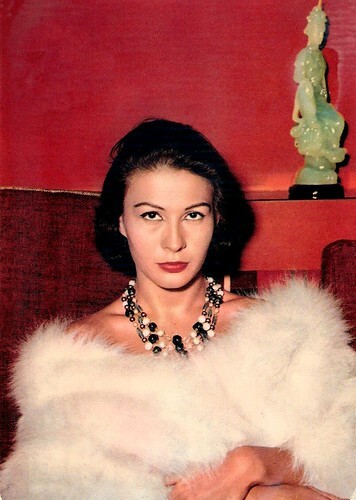
Italian postcard by Rotalcolour, no. 79.
An anti-Communist propaganda film
Franca Bettoia (sometimes written as Bettoja) was born in 1936 in Rome, Italy.
Her first film appearance was in Un Palco all'opera (Siro Marcellini, 1955). The following year she played a supporting part in the Spanish-Italian production Los amantes del desierto/Desert Warrior (Goffredo Alessandrini a.o., 1956), but the lush desert epic wasn't released until two years later. It starred Riccardo Montalban , Carmen Sevilla and Gino Cervi .
Next Franca appeared opposite Pietro Germi in L’Uomo di paglia/A Man of Straw (Pietro Germi, 1958), and opposite Macha Méril and Jacques Charrier in the French production La main chaude/The Itchy Palm (Gérard Oury, 1960).
She appeared as a nun in China in Apocalisse sul fiume giallo/The Dam on the Yellow River (Renzo Merusi, 1960), an anti-Communist propaganda film, in which the victory of Mao Tse-Tung's People's Liberation Army is seen through the eyes of an American journalist ( Georges Marchal ) reporting from the Nationalists' side.
The next year she starred opposite Hollywood star Alan Ladd at the end of his career in Orazi e curiazi/Duel of the Champions (Terence Young, Ferdinando Baldi, 1961), a Peplum (a Sword and Sandals adventure) set in ancient Rome. The screenplay was written by such prestigious writers as Carlo Lizzani, Giuliano Montaldo and Luciano Vincenzoni, Sergio Leone's usual script writer.
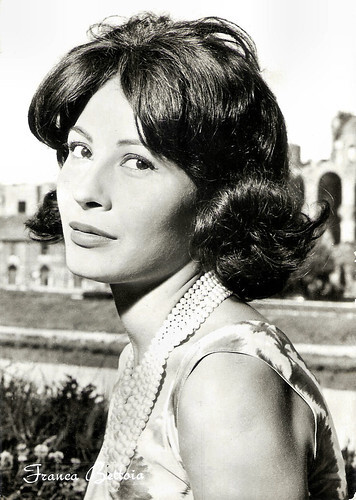
Italian postcard by Rotalfoto, Milano, no. 897.
Vampire-like creatures
In 1964 Franca Bettoia co-starred with Vincent Price in the Horror/Science Fiction film L'Ultimo uomo della Terra/The Last Man on Earth (Ubaldo Ragone, Sidney Salkow, 1964). This was the first screen version of Richard Matheson's novel 'I Am Legend', later filmed again as The Omega Man (Boris Sagal, 1971) with Charlton Heston , and as I Am Legend (Francis Lawrence, 2007), starring Will Smith .
The script was written in part by Matheson, but he was dissatisfied with the result and was therefore credited as Logan Swanson. William Leicester, Furio M. Monetti, and Ubaldo Ragona were the other writers. In the year 1968, Dr. Robert Morgan ( Vincent Price ) wakes up to find a world where everyone else has been infected by a disease that turns them into vampire-like creatures. During the day he gathers his weapons and goes out vampire hunting and by night he locks himself inside his house. One day he finds a beautiful woman (Franca Bettoia) who seems disease-free and takes her home but he becomes suspicious when he catches her injecting himself with a serum. She then explains that there are others like her trying to rebuild civilisation.
Next Franca Bettoia was a princess in distress opposite Ray Danton and Guy Madison in the adventure films Sandokan alla riscossa/Sandokan Fights Back (Luigi Capuano, 1964) and Sandokan contro il leopardo di Sarawak/Sandokan Against the Leopard of Sarawak (Luigi Capuano, 1964). In 1967 she appeared as Ugo Tognazzi ’s lover in the social comedy Il fischio al naso/The Seventh Floor (1967). Tognazzi also produced and directed the film. He played a successful businessman who occasionally develops an unusual physical disturbance: his nose whistles, whenever he breathes. Bettoia and Tognazzi became also lovers in real life and they were married in 1972.
Franca Bettoia would play in only three more films, which were all of interest. In the comedy Riusciranno i nostri eroi a ritrovare l'amico misteriosamente scomparso in Africa?/Will Our Heroes Be Able to Find Their Friend Who Has Mysteriously Disappeared in Africa? (Ettore Scola, 1968) she appeared as the wife of Alberto Sordi, a rich businessman who is fed up with work, family, and society, and goes with a friend ( Bernard Blier ) to Africa, in search of another friend who had vanished there in mysterious circumstances. They find him as a tribal chief, surrounded by topless, shapely wives.
In her next film, Touche pas à la femme blanche/Don’t Touch the White Woman (Marco Ferreri, 1974), the stars were Catherine Deneuve , Marcello Mastroianni and Michel Piccoli . The film tells a page of shame in American history as General George Custer prepared, and later battled, the Indians in the battle of Little Big Horn which was his last stand as a military man. Director Marco Ferreri staged his film on a construction site in the centre of Paris. (The site where the Pompidou Center would be erected). Franca Bettoia's last film, Teste rasate/Skinhead (Claudio Fragasso, 1993) is a drama about skinheads, in which she played the mother of the lead character played by her son, Gianmarco Tognazzi. Franca Bettoia and Ugo Tognazzi , who died in 1990, also had a daughter, film director Maria Sole Tognazzi. Franca Bettoia died in in Rome at the Gemelli Polyclinic, where she was hospitalised for pneumonia, in 2024, at the age of 88.
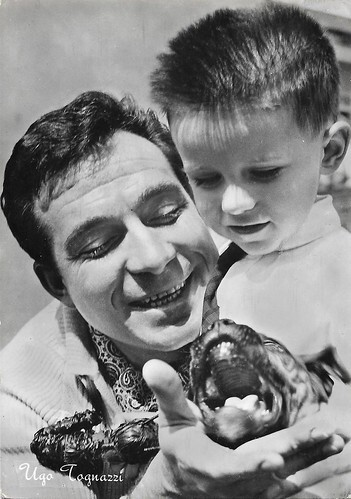
Ugo Tognazzi . Italian postcard by Rotalfoto, no. 796.
Sources: Wikipedia (English and Italian) and .

Italian postcard by Rotalcolour, no. 79.
An anti-Communist propaganda film
Franca Bettoia (sometimes written as Bettoja) was born in 1936 in Rome, Italy.
Her first film appearance was in Un Palco all'opera (Siro Marcellini, 1955). The following year she played a supporting part in the Spanish-Italian production Los amantes del desierto/Desert Warrior (Goffredo Alessandrini a.o., 1956), but the lush desert epic wasn't released until two years later. It starred Riccardo Montalban , Carmen Sevilla and Gino Cervi .
Next Franca appeared opposite Pietro Germi in L’Uomo di paglia/A Man of Straw (Pietro Germi, 1958), and opposite Macha Méril and Jacques Charrier in the French production La main chaude/The Itchy Palm (Gérard Oury, 1960).
She appeared as a nun in China in Apocalisse sul fiume giallo/The Dam on the Yellow River (Renzo Merusi, 1960), an anti-Communist propaganda film, in which the victory of Mao Tse-Tung's People's Liberation Army is seen through the eyes of an American journalist ( Georges Marchal ) reporting from the Nationalists' side.
The next year she starred opposite Hollywood star Alan Ladd at the end of his career in Orazi e curiazi/Duel of the Champions (Terence Young, Ferdinando Baldi, 1961), a Peplum (a Sword and Sandals adventure) set in ancient Rome. The screenplay was written by such prestigious writers as Carlo Lizzani, Giuliano Montaldo and Luciano Vincenzoni, Sergio Leone's usual script writer.

Italian postcard by Rotalfoto, Milano, no. 897.
Vampire-like creatures
In 1964 Franca Bettoia co-starred with Vincent Price in the Horror/Science Fiction film L'Ultimo uomo della Terra/The Last Man on Earth (Ubaldo Ragone, Sidney Salkow, 1964). This was the first screen version of Richard Matheson's novel 'I Am Legend', later filmed again as The Omega Man (Boris Sagal, 1971) with Charlton Heston , and as I Am Legend (Francis Lawrence, 2007), starring Will Smith .
The script was written in part by Matheson, but he was dissatisfied with the result and was therefore credited as Logan Swanson. William Leicester, Furio M. Monetti, and Ubaldo Ragona were the other writers. In the year 1968, Dr. Robert Morgan ( Vincent Price ) wakes up to find a world where everyone else has been infected by a disease that turns them into vampire-like creatures. During the day he gathers his weapons and goes out vampire hunting and by night he locks himself inside his house. One day he finds a beautiful woman (Franca Bettoia) who seems disease-free and takes her home but he becomes suspicious when he catches her injecting himself with a serum. She then explains that there are others like her trying to rebuild civilisation.
Next Franca Bettoia was a princess in distress opposite Ray Danton and Guy Madison in the adventure films Sandokan alla riscossa/Sandokan Fights Back (Luigi Capuano, 1964) and Sandokan contro il leopardo di Sarawak/Sandokan Against the Leopard of Sarawak (Luigi Capuano, 1964). In 1967 she appeared as Ugo Tognazzi ’s lover in the social comedy Il fischio al naso/The Seventh Floor (1967). Tognazzi also produced and directed the film. He played a successful businessman who occasionally develops an unusual physical disturbance: his nose whistles, whenever he breathes. Bettoia and Tognazzi became also lovers in real life and they were married in 1972.
Franca Bettoia would play in only three more films, which were all of interest. In the comedy Riusciranno i nostri eroi a ritrovare l'amico misteriosamente scomparso in Africa?/Will Our Heroes Be Able to Find Their Friend Who Has Mysteriously Disappeared in Africa? (Ettore Scola, 1968) she appeared as the wife of Alberto Sordi, a rich businessman who is fed up with work, family, and society, and goes with a friend ( Bernard Blier ) to Africa, in search of another friend who had vanished there in mysterious circumstances. They find him as a tribal chief, surrounded by topless, shapely wives.
In her next film, Touche pas à la femme blanche/Don’t Touch the White Woman (Marco Ferreri, 1974), the stars were Catherine Deneuve , Marcello Mastroianni and Michel Piccoli . The film tells a page of shame in American history as General George Custer prepared, and later battled, the Indians in the battle of Little Big Horn which was his last stand as a military man. Director Marco Ferreri staged his film on a construction site in the centre of Paris. (The site where the Pompidou Center would be erected). Franca Bettoia's last film, Teste rasate/Skinhead (Claudio Fragasso, 1993) is a drama about skinheads, in which she played the mother of the lead character played by her son, Gianmarco Tognazzi. Franca Bettoia and Ugo Tognazzi , who died in 1990, also had a daughter, film director Maria Sole Tognazzi. Franca Bettoia died in in Rome at the Gemelli Polyclinic, where she was hospitalised for pneumonia, in 2024, at the age of 88.

Ugo Tognazzi . Italian postcard by Rotalfoto, no. 796.
Sources: Wikipedia (English and Italian) and .
Published on October 19, 2024 22:00
October 18, 2024
Mitzi Gaynor (1932-2024)
Bright-eyed American actress, singer, and dancer Mitzi Gaynor (1931) died Thursday, 17 October 2024. She was a leading lady in light musicals, including There's No Business Like Show Business (1954), which featured Irving Berlin's music and starred Ethel Merman, and South Pacific (1958), based on the musical by Rodgers and Hammerstein. Mitzi Gaynor was 93.
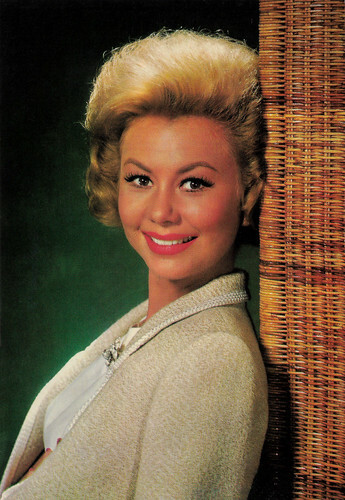
Spanish postcard by Postal Oscarcolor, S.L., no. 8.
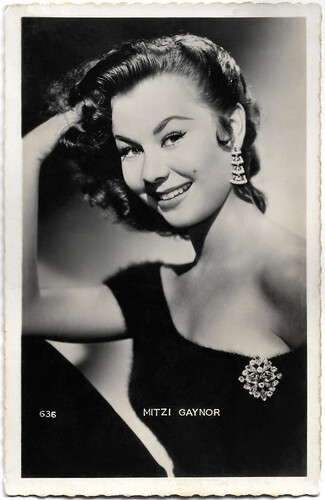
French postcard by Editions P.I., Paris, no. 636.
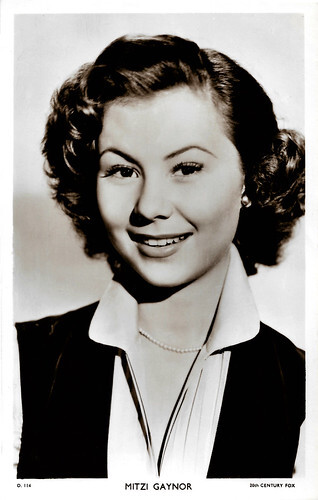
British postcard in the Picturegoer Series, London, no. D. 114. Photo: 20th Century Fox.
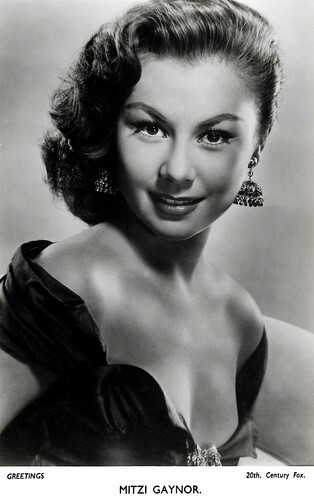
British postcard in the Greetings series. Photo: 20th Century Fox.
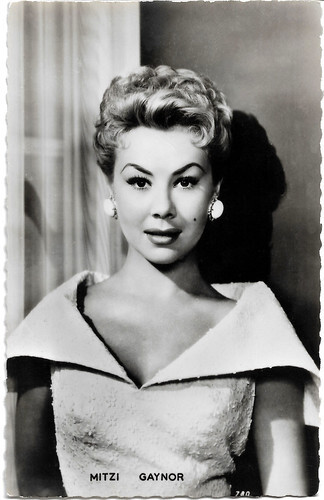
French postcard by Editions P.I., Paris, no. 780. Photo: Paramount Pictures, 1956.
Starting her career as a chorus dancer at 12
Mitzi Gaynor was born as Francesca Marlene de Czanyi von Gerber in 1931, in Chicago, Illinois. She was the daughter of Pauline, a dancer, and Henry von Gerber, a violinist, cellist, and music director. After her father remarried, she became step-sister to anti-war activist Donald W. Duncan. Her family first moved to Elgin, Illinois, then to Detroit, and later when she was eleven, to Hollywood.
She trained as a ballerina as a child and began her career as a chorus dancer. At 12, she joined the dancing chorus of the Los Angeles Civic Light Opera. She lied about her address so she could attend Hollywood High School.
In 1950, she signed a seven-year contract with Twentieth Century Fox where she sang, acted, and danced in several film musicals. A Fox Studio executive thought that Mitzi Gerber sounded like the name of a delicatessen, and they came up with a name that used the same initials. Gaynor made her film debut in a musical, My Blue Heaven (Henry Koster, 1950) supporting Betty Grable and Dan Dailey.
She followed it with a college drama Take Care of My Little Girl (Jean Negulesco, 1951), where she played the roommate of Jeanne Crain . Fox then gave Gaynor a star part, in the musical biopic Golden Girl (Lloyd Bacon, 1951). It was a mild success at the box office. Gaynor was one of several stars in the anthology comedy We're Not Married! (Edmund Goulding, 1952) with Ginger Rogers and Marilyn Monroe , and she was top-billed in the musical, Bloodhounds of Broadway (Harmon Jones, 1952).
Fox put her in another biopic, The I Don't Care Girl (Lloyd Bacon, 1952), where she played Ziegfeld star Eva Tanguay. Gaynor starred in Down Among the Sheltering Palms (Edmund Goulding, 1953), playing a South Sea island girl. She was the female lead in a Western, Three Young Texans (Henry Levin, 1954) with Jeffrey Hunter . Gaynor's most popular film in her time at Fox was There's No Business Like Show Business (Walter Lang, 1954), where she was billed after Ethel Merman, Dan Dailey, Marilyn Monroe , Donald O'Connor and Johnnie Ray.
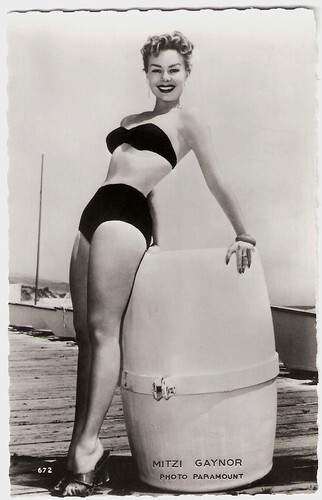
French postcard by Editions P.I., Paris, no. 672, offered by Les Carbones Korès Carboplane. Photo: Paramount.
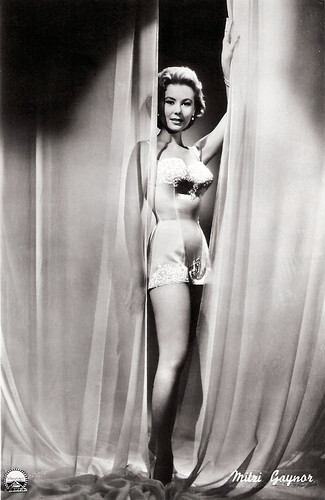
Belgian postcard by Bromophoto, Bruxelles (Brussels). Photo: Paramount.
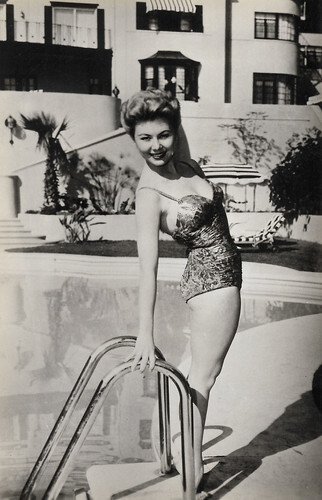
Spanish postcard by Ediciones Raker, Barcelona, no. 23. Photo: M.G.M., 1959.
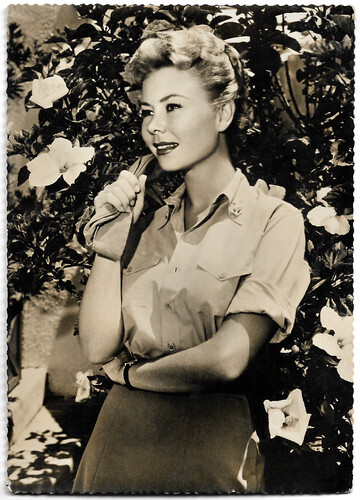
Yugoslavian postcard by 3K, no. 2915.
A major draw on the nightclub and summer musical circuit
In 1954, Mitzi Gaynor married Jack Bean, a talent agent and public relations executive for MCA, in San Francisco, California. She had just been released from Twentieth Century-Fox (before the start of There's No Business Like Show Business) with four years left on her contract and decided with the time off to get married. The union was childless.
After their wedding, Bean quit MCA, started his own real estate business and managed Gaynor's career. Bean wisely perceived that his new bride was a far more effective performer on a live stage than a film set. In 1956, Gaynor appeared in the Paramount remake of Anything Goes (Robert Lewis, 1956), co-starring Bing Crosby , Donald O'Connor , and Zizi Jeanmaire , loosely based on the musical by Cole Porter, P.G. Wodehouse and Guy Bolton.
Paramount cast her in another remake, The Birds and the Bees (Norman Taurog, 1956) with David Niven , playing the role originated by Barbara Stanwyck in The Lady Eve (Preston Sturges, 1941). Her third film for Paramount was The Joker Is Wild (Charles Vidor, 1957), a biopic of famous comedian Joe E. Lewis ( Frank Sinatra ) in which Gaynor played the female lead. In 1957, Gaynor appeared in MGM's Les Girls (George Cukor, 1957), with Gene Kelly and Kay Kendall .
Her biggest international fame came from the plum role of Nellie Forbush in the film version of Rodgers and Hammerstein's South Pacific (Joshua Logan, 1958), starring Rossano Brazzi . She was nominated for a Best Actress Golden Globe Award for her performance. Gaynor followed this with a comedy at MGM, Happy Anniversary (David Miller, 1959) opposite David Niven , and the British musical comedy thriller Surprise Package (Stanley Donen, 1960), with Yul Brynner and Noël Coward. Her last film role was For Love or Money (Michael Gordon, 1963), starring Kirk Douglas .
Mitzi Gaynor's film career was over, but happily, she continued to be a major draw on the nightclub and summer musical circuit. She often performed songs at Academy Awards ceremonies. At the 1967 Oscar telecast, she sang the theme from the film Georgy Girl (Silvio Narizzano, 1966) and stopped the show. The Academy had difficulty getting the audience to sit down and stop applauding. Gaynor later added the number to her concert repertoire. Throughout the 1960s and 1970s, she starred in nine acclaimed television specials that garnered 16 Emmy nominations. During the 1990s, Gaynor also became a featured columnist for the influential magazine The Hollywood Reporter. Her husband Jack Bean died in 2006. Mitzi passed away peacefully on 17 October 2024 of natural causes.
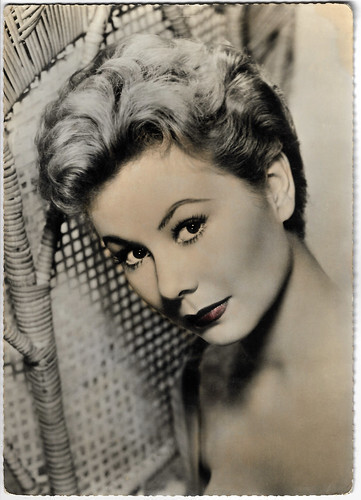
Yugoslavian postcard by 3K, no. 2944.
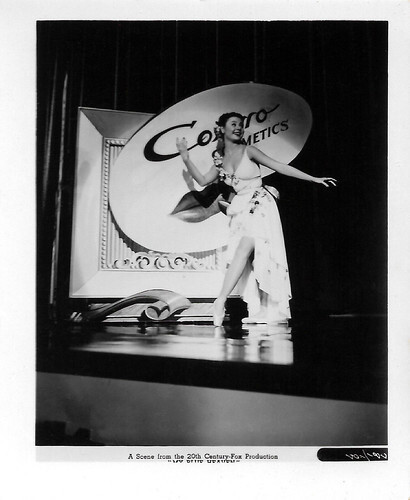
Vintage photo by 20th Century Fox. Mitzi Gaynor in My Blue Heaven (Henry Koster, 1950).
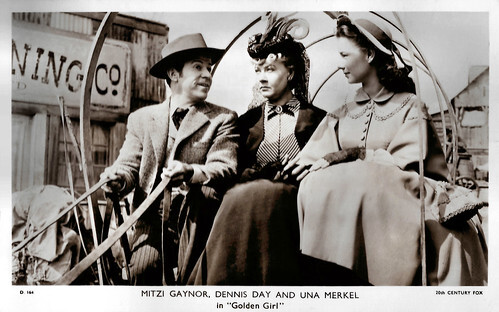
British postcard in the Picturegoer Series, London, no. D 164. Photo: Metro-Goldwyn-Mayer (MGM). Mitzi Gaynor (right), Dennis Day and Una Merkel in Golden Girl (Lloyd Bacon, 1951).
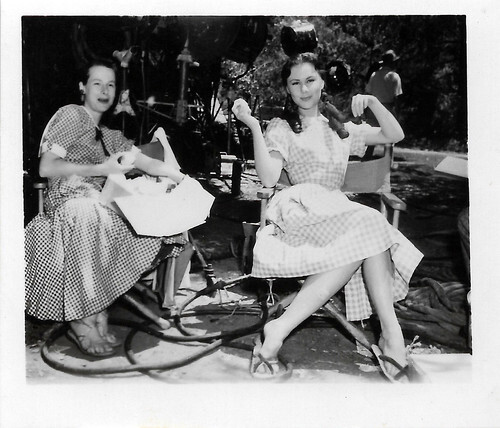
Vintage set photo.
Sources: AllMovie, Wikipedia and .

Spanish postcard by Postal Oscarcolor, S.L., no. 8.

French postcard by Editions P.I., Paris, no. 636.

British postcard in the Picturegoer Series, London, no. D. 114. Photo: 20th Century Fox.

British postcard in the Greetings series. Photo: 20th Century Fox.

French postcard by Editions P.I., Paris, no. 780. Photo: Paramount Pictures, 1956.
Starting her career as a chorus dancer at 12
Mitzi Gaynor was born as Francesca Marlene de Czanyi von Gerber in 1931, in Chicago, Illinois. She was the daughter of Pauline, a dancer, and Henry von Gerber, a violinist, cellist, and music director. After her father remarried, she became step-sister to anti-war activist Donald W. Duncan. Her family first moved to Elgin, Illinois, then to Detroit, and later when she was eleven, to Hollywood.
She trained as a ballerina as a child and began her career as a chorus dancer. At 12, she joined the dancing chorus of the Los Angeles Civic Light Opera. She lied about her address so she could attend Hollywood High School.
In 1950, she signed a seven-year contract with Twentieth Century Fox where she sang, acted, and danced in several film musicals. A Fox Studio executive thought that Mitzi Gerber sounded like the name of a delicatessen, and they came up with a name that used the same initials. Gaynor made her film debut in a musical, My Blue Heaven (Henry Koster, 1950) supporting Betty Grable and Dan Dailey.
She followed it with a college drama Take Care of My Little Girl (Jean Negulesco, 1951), where she played the roommate of Jeanne Crain . Fox then gave Gaynor a star part, in the musical biopic Golden Girl (Lloyd Bacon, 1951). It was a mild success at the box office. Gaynor was one of several stars in the anthology comedy We're Not Married! (Edmund Goulding, 1952) with Ginger Rogers and Marilyn Monroe , and she was top-billed in the musical, Bloodhounds of Broadway (Harmon Jones, 1952).
Fox put her in another biopic, The I Don't Care Girl (Lloyd Bacon, 1952), where she played Ziegfeld star Eva Tanguay. Gaynor starred in Down Among the Sheltering Palms (Edmund Goulding, 1953), playing a South Sea island girl. She was the female lead in a Western, Three Young Texans (Henry Levin, 1954) with Jeffrey Hunter . Gaynor's most popular film in her time at Fox was There's No Business Like Show Business (Walter Lang, 1954), where she was billed after Ethel Merman, Dan Dailey, Marilyn Monroe , Donald O'Connor and Johnnie Ray.

French postcard by Editions P.I., Paris, no. 672, offered by Les Carbones Korès Carboplane. Photo: Paramount.

Belgian postcard by Bromophoto, Bruxelles (Brussels). Photo: Paramount.

Spanish postcard by Ediciones Raker, Barcelona, no. 23. Photo: M.G.M., 1959.

Yugoslavian postcard by 3K, no. 2915.
A major draw on the nightclub and summer musical circuit
In 1954, Mitzi Gaynor married Jack Bean, a talent agent and public relations executive for MCA, in San Francisco, California. She had just been released from Twentieth Century-Fox (before the start of There's No Business Like Show Business) with four years left on her contract and decided with the time off to get married. The union was childless.
After their wedding, Bean quit MCA, started his own real estate business and managed Gaynor's career. Bean wisely perceived that his new bride was a far more effective performer on a live stage than a film set. In 1956, Gaynor appeared in the Paramount remake of Anything Goes (Robert Lewis, 1956), co-starring Bing Crosby , Donald O'Connor , and Zizi Jeanmaire , loosely based on the musical by Cole Porter, P.G. Wodehouse and Guy Bolton.
Paramount cast her in another remake, The Birds and the Bees (Norman Taurog, 1956) with David Niven , playing the role originated by Barbara Stanwyck in The Lady Eve (Preston Sturges, 1941). Her third film for Paramount was The Joker Is Wild (Charles Vidor, 1957), a biopic of famous comedian Joe E. Lewis ( Frank Sinatra ) in which Gaynor played the female lead. In 1957, Gaynor appeared in MGM's Les Girls (George Cukor, 1957), with Gene Kelly and Kay Kendall .
Her biggest international fame came from the plum role of Nellie Forbush in the film version of Rodgers and Hammerstein's South Pacific (Joshua Logan, 1958), starring Rossano Brazzi . She was nominated for a Best Actress Golden Globe Award for her performance. Gaynor followed this with a comedy at MGM, Happy Anniversary (David Miller, 1959) opposite David Niven , and the British musical comedy thriller Surprise Package (Stanley Donen, 1960), with Yul Brynner and Noël Coward. Her last film role was For Love or Money (Michael Gordon, 1963), starring Kirk Douglas .
Mitzi Gaynor's film career was over, but happily, she continued to be a major draw on the nightclub and summer musical circuit. She often performed songs at Academy Awards ceremonies. At the 1967 Oscar telecast, she sang the theme from the film Georgy Girl (Silvio Narizzano, 1966) and stopped the show. The Academy had difficulty getting the audience to sit down and stop applauding. Gaynor later added the number to her concert repertoire. Throughout the 1960s and 1970s, she starred in nine acclaimed television specials that garnered 16 Emmy nominations. During the 1990s, Gaynor also became a featured columnist for the influential magazine The Hollywood Reporter. Her husband Jack Bean died in 2006. Mitzi passed away peacefully on 17 October 2024 of natural causes.

Yugoslavian postcard by 3K, no. 2944.

Vintage photo by 20th Century Fox. Mitzi Gaynor in My Blue Heaven (Henry Koster, 1950).

British postcard in the Picturegoer Series, London, no. D 164. Photo: Metro-Goldwyn-Mayer (MGM). Mitzi Gaynor (right), Dennis Day and Una Merkel in Golden Girl (Lloyd Bacon, 1951).

Vintage set photo.
Sources: AllMovie, Wikipedia and .
Published on October 18, 2024 22:00
October 17, 2024
Adriana Benetti
Adriana Benetti (1919–2016) was an Italian actress, who peaked in the 1940s and 1950s.
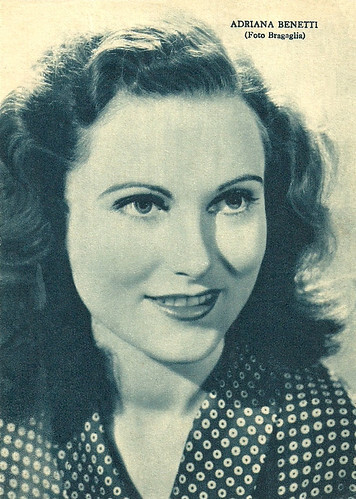
Italian postcard by Rizzoli, Milano, 1942. Photo: Bragaglia. Adriana Benetti in Teresa Venerdi (Vittorio De Sica, 1941).
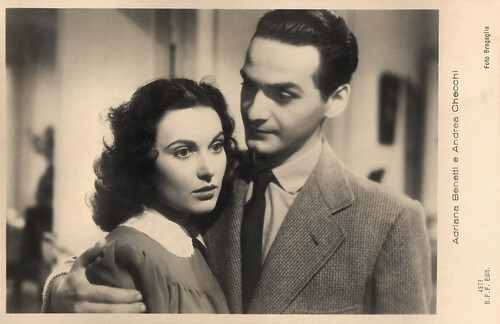
Italian postcard by B.F.F. Edit., no. 4377. Photo: Bragaglia. Adriana Benetti and Andrea Checchi in Avanti c'è posto/There's Room Up Ahead (Mario Bonnard, 1942).
A career catapulted
Adriana Benetti was born in Quacchio, a town east of Ferrara, in 1919.
She graduated from the Istituto Magistrale at Ferrara, after which she moved to Rome where she was admitted to the film academy Centro Sperimentale di Cinematografia. While attending her courses she was discovered by Vittorio De Sica , who directed her film debut in 1941.
She played the role of protagonist in Teresa Venerdí/Doctor Beware (Vittorio De Sica, 1941). This White Telephone drama was a remake of the Hungarian comedy Péntek Rézi/Rézi Friday (Ladislao Vajda, 1938). Benetti showed her talent in a scene in which she tries to separate her favourite man, dr. Pietro Vignali (De Sica himself) from his spendthrift Vaudeville girlfriend Loletta Prima ( Anna Magnani ), by giving it all the melodrama needed to chase the girlfriend.
Benetti's film career then catapulted. She peaked in the 1940s and early 1950s. Alessandro Blasetti directed her in his famous Quattro passi fra le nuvole/Four Steps in the Clouds (1942). It tells the story of a married man who agrees to act as the husband of a young pregnant woman who has been abandoned by her boyfriend. Aesthetically, it is close to Italian neorealism. In this film, she was first paired with Gino Cervi.
Luigi Zampa directed her in the White Telephone drama C'è sempre un ma!/There's Always a But! (Luigi Zampa, 1942) starring Carla Del Poggio . Then she starred opposite Andrea Checchi and Aldo Fabrizi in the comedy Avanti c'è posto/Before the Postman (Mario Bonnard, 1942). It was Fabrizi's first starring film. Alongside Massimo Serato and Vittorio Sanipoli, Benedetti acted in Quartieri alti/In High Places (Mario Soldati, 1943).
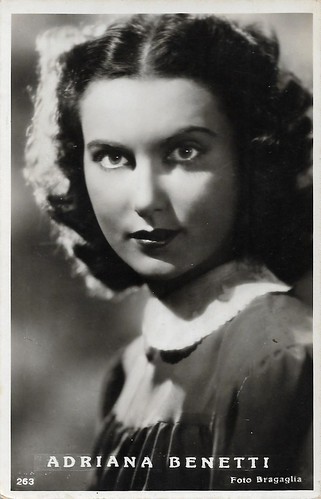
Italian postcard by A. Terzoli, Roma / Stabilimenti Angeli, Terni, no. 263. Photo: Bragaglia.
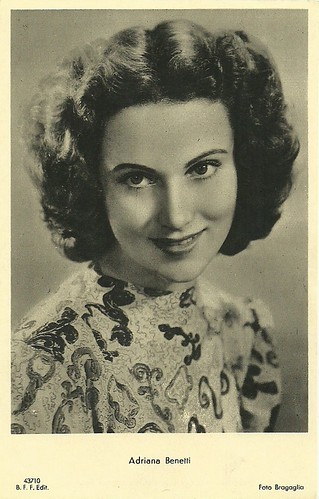
Italian postcard by B.F.F. (Ballerini & Fratini, Firenze) Editori, no. 43710. Photo: Bragaglia.
Italy's little fiancée
After the war, Adriana Benetti took part in two musical films in 1945. First, she was the partner of Gino Bechi in Torna ... a Sorrento (C.L. Bragaglia, 1945), then of Opera star Tito Gobbi in the war drama O sole mio/My Sun (Giacomo Gentilomo, 1945). Later she acted with Fosco Giachetti in Il sole di Montecassino/Fear No Evil (G.M. Scotese, 1946), and with Eduardo and Titina De Filippo in Uno tra la folla (Ennio Cerlesi, 1946).
Goffredo Alessandrini directed her in Furia/Fury (1947), a film in which she once again starred alongside Gino Cervi and as well with Rossano Brazzi . After that, she returned to the set with Fabrizi in Tombolo, paradiso nero (Giorgio Ferroni, 1947). In 1950 she was a partner of Toto in the comedy 47 morto che parla/47 Dead Men Speaking (Carlo Ludovico Bragaglia, 1950). Benetti specialised in roles characterised by simplicity or naivety. She was called the 'fidanzatina d'Italia' (Italy's little fiancée), a term that was coined to distinguish her from Assia Noris who was called 'Italy's fiancée'.
French director André Cayatte wrote the script for the Italian film Manù il contrabbandiere/Under the Cards (Lucio De Caro, 1947). Marcel L'Herbier and Paolo Moffa directed her in French-Italian historical drama, Gli ultimi giorni di Pompei/The Last Days of Pompeii (1950), in which she played Nidia. Unfortunately, in the original novel on which the film is based, Nidia is one of the central characters, but in this film, she is killed off early in the film by the evil priest Arbax (Marcel Herrand).
Benetti also acted in some Spanish and Argentinian films, such as Hugo del Carril's Argentinian film Las aguas bajan turbias)/Dark River (1952). In the 1950s, she gradually lost popularity, with the fading of the characteristics that distinguished her so much. She played the music teacher in the comedy Le diciottenni/Eighteen Year Olds (Mario Mattoli, 1955), starring Marisa Allasio .
Benetti played the mature girlfriend in A vent'anni è sempre festa/In Your Twenties It's Always a Party (Vittorio Duse, 1957), the film with which she closed her film career. Precisely because of that aura of the eternal naive one, that so distinguished her and that had made her famous, in 1947 she scandalised Italy at the time by posing in a bikini for the illustrated weekly Tempo. Adriana Benetti died in Rome in 2016, at the high age of 96 years.
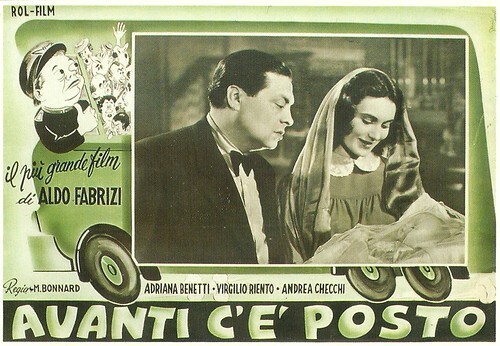
Italian modern postcard by Ed. Gel. Photo: Rol Film. Aldo Fabrizi and Adriana Benetti in the Italian film comedy Avanti c'é posto/Come in, There is Place Enough... (Mario Bonnard, 1942). The plot deals with a bus attendant (Fabrizi) who helps a poor young girl (Benetti). He falls in love with her, but she prefers his younger colleague ( Andrea Checchi ).
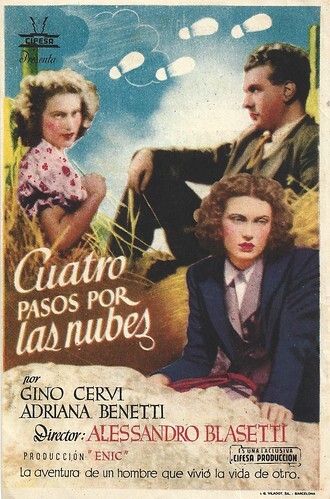
Spanish leaflet by Cifesa Produccion, using the Spanish poster for the Italian film Quattro passi fra le nuvole/Four Steps in the Clouds (Alessandro Blasetti, 1942), starring Gino Cervi and Adriana Benetti. Caption: The adventure of a man who lived the life of another. Publicity for the showing of this film alternated with the American film Dark Victory (Edmund Goulding, 1939) at the Madrid-based Cine Victoria, which opened in 1940.
Sources: Wikipedia (Italian and English) and .

Italian postcard by Rizzoli, Milano, 1942. Photo: Bragaglia. Adriana Benetti in Teresa Venerdi (Vittorio De Sica, 1941).

Italian postcard by B.F.F. Edit., no. 4377. Photo: Bragaglia. Adriana Benetti and Andrea Checchi in Avanti c'è posto/There's Room Up Ahead (Mario Bonnard, 1942).
A career catapulted
Adriana Benetti was born in Quacchio, a town east of Ferrara, in 1919.
She graduated from the Istituto Magistrale at Ferrara, after which she moved to Rome where she was admitted to the film academy Centro Sperimentale di Cinematografia. While attending her courses she was discovered by Vittorio De Sica , who directed her film debut in 1941.
She played the role of protagonist in Teresa Venerdí/Doctor Beware (Vittorio De Sica, 1941). This White Telephone drama was a remake of the Hungarian comedy Péntek Rézi/Rézi Friday (Ladislao Vajda, 1938). Benetti showed her talent in a scene in which she tries to separate her favourite man, dr. Pietro Vignali (De Sica himself) from his spendthrift Vaudeville girlfriend Loletta Prima ( Anna Magnani ), by giving it all the melodrama needed to chase the girlfriend.
Benetti's film career then catapulted. She peaked in the 1940s and early 1950s. Alessandro Blasetti directed her in his famous Quattro passi fra le nuvole/Four Steps in the Clouds (1942). It tells the story of a married man who agrees to act as the husband of a young pregnant woman who has been abandoned by her boyfriend. Aesthetically, it is close to Italian neorealism. In this film, she was first paired with Gino Cervi.
Luigi Zampa directed her in the White Telephone drama C'è sempre un ma!/There's Always a But! (Luigi Zampa, 1942) starring Carla Del Poggio . Then she starred opposite Andrea Checchi and Aldo Fabrizi in the comedy Avanti c'è posto/Before the Postman (Mario Bonnard, 1942). It was Fabrizi's first starring film. Alongside Massimo Serato and Vittorio Sanipoli, Benedetti acted in Quartieri alti/In High Places (Mario Soldati, 1943).

Italian postcard by A. Terzoli, Roma / Stabilimenti Angeli, Terni, no. 263. Photo: Bragaglia.

Italian postcard by B.F.F. (Ballerini & Fratini, Firenze) Editori, no. 43710. Photo: Bragaglia.
Italy's little fiancée
After the war, Adriana Benetti took part in two musical films in 1945. First, she was the partner of Gino Bechi in Torna ... a Sorrento (C.L. Bragaglia, 1945), then of Opera star Tito Gobbi in the war drama O sole mio/My Sun (Giacomo Gentilomo, 1945). Later she acted with Fosco Giachetti in Il sole di Montecassino/Fear No Evil (G.M. Scotese, 1946), and with Eduardo and Titina De Filippo in Uno tra la folla (Ennio Cerlesi, 1946).
Goffredo Alessandrini directed her in Furia/Fury (1947), a film in which she once again starred alongside Gino Cervi and as well with Rossano Brazzi . After that, she returned to the set with Fabrizi in Tombolo, paradiso nero (Giorgio Ferroni, 1947). In 1950 she was a partner of Toto in the comedy 47 morto che parla/47 Dead Men Speaking (Carlo Ludovico Bragaglia, 1950). Benetti specialised in roles characterised by simplicity or naivety. She was called the 'fidanzatina d'Italia' (Italy's little fiancée), a term that was coined to distinguish her from Assia Noris who was called 'Italy's fiancée'.
French director André Cayatte wrote the script for the Italian film Manù il contrabbandiere/Under the Cards (Lucio De Caro, 1947). Marcel L'Herbier and Paolo Moffa directed her in French-Italian historical drama, Gli ultimi giorni di Pompei/The Last Days of Pompeii (1950), in which she played Nidia. Unfortunately, in the original novel on which the film is based, Nidia is one of the central characters, but in this film, she is killed off early in the film by the evil priest Arbax (Marcel Herrand).
Benetti also acted in some Spanish and Argentinian films, such as Hugo del Carril's Argentinian film Las aguas bajan turbias)/Dark River (1952). In the 1950s, she gradually lost popularity, with the fading of the characteristics that distinguished her so much. She played the music teacher in the comedy Le diciottenni/Eighteen Year Olds (Mario Mattoli, 1955), starring Marisa Allasio .
Benetti played the mature girlfriend in A vent'anni è sempre festa/In Your Twenties It's Always a Party (Vittorio Duse, 1957), the film with which she closed her film career. Precisely because of that aura of the eternal naive one, that so distinguished her and that had made her famous, in 1947 she scandalised Italy at the time by posing in a bikini for the illustrated weekly Tempo. Adriana Benetti died in Rome in 2016, at the high age of 96 years.

Italian modern postcard by Ed. Gel. Photo: Rol Film. Aldo Fabrizi and Adriana Benetti in the Italian film comedy Avanti c'é posto/Come in, There is Place Enough... (Mario Bonnard, 1942). The plot deals with a bus attendant (Fabrizi) who helps a poor young girl (Benetti). He falls in love with her, but she prefers his younger colleague ( Andrea Checchi ).

Spanish leaflet by Cifesa Produccion, using the Spanish poster for the Italian film Quattro passi fra le nuvole/Four Steps in the Clouds (Alessandro Blasetti, 1942), starring Gino Cervi and Adriana Benetti. Caption: The adventure of a man who lived the life of another. Publicity for the showing of this film alternated with the American film Dark Victory (Edmund Goulding, 1939) at the Madrid-based Cine Victoria, which opened in 1940.
Sources: Wikipedia (Italian and English) and .
Published on October 17, 2024 22:00
October 16, 2024
Marcella Sabbatini
Marcella Sabbatini (1914-2001) was an Italian child actress of the silent screen. She played the child of many divas
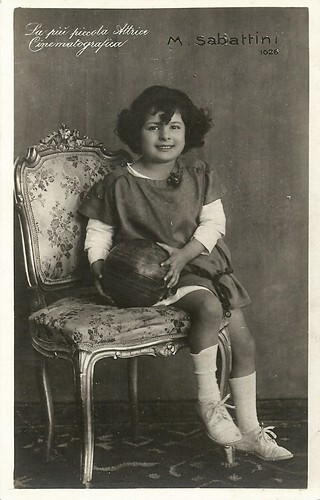
Italian postcard by Vettori, Bologna, no. 1026. "La più piccola Attrice Cinematografica" (The youngest film actress). Sabbatini's name is misspelled here as Sabattini.
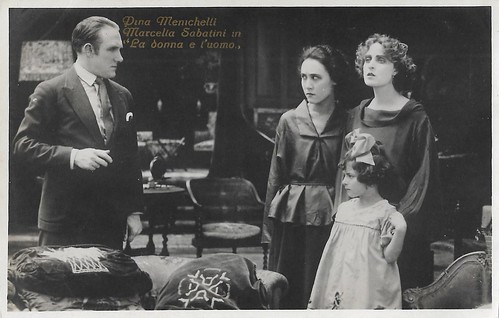
Italian postcard by G.B. Falci, Milano. Photo: Fotominio. Pina Menichelli , Milton Rosmer and Marcella Sabbatini in La donna e l'uomo/Woman and Man (Amleto Palermi, 1923).
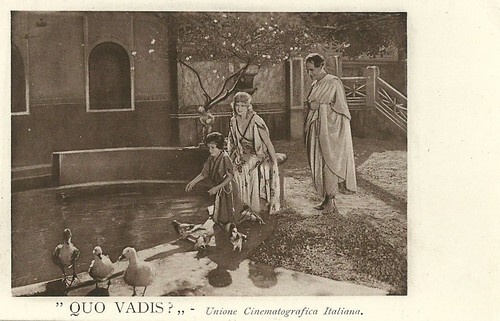
Italian postcard by Edizione L'Argentografica, Torino, no. 3049. Lillian Hall-Davis as Lygia/Licia, Alphons Fryland as Vinicius and Marcella Sabbatini as the son of Domitilla and Plautus the Italo-German epic Quo Vadis? (Gabriellino D'Annunzio, Georg Jacoby, 1924), one of the many adaptations of the classic novel by Henryk Sienkiewicz.
A celebrated child actress in Italian silent films
Marcella Sabbatini was born in Rome in 1914 into a family of revue and operetta actors. She made her film debut in 1919, while still a child, in a film by Celio. In addition to numerous films, she was portrayed, alone and with actresses such as Pina Menichelli in a series of postcards with publicity photos.
Her career took off and between 1919 and 1926 she became a celebrated child actress in Italian silent films, with over thirty films, gaining child star status. In 1919, she made her film debut in Mario Bonnard 's Germana, with Maria Caserini and Mina D'Orvella. She remained with Bonnard in several subsequent films, including Per un figlio (1920), again with Caserini and D'Orvella, followed by Papa Lebonard (1920) with Ugo Piperno in the title role.
Together with Ettore Casarotti, the duo Arnold and Patata (Aldo Mezzanotte), Franco Cappelli and Mimmo Palermi, Sabbatini was part of a new generation of Italian child actors who had established themselves in those years, before the crisis in Italian film production, with the bankruptcy of the U.C.I., interrupted their careers.
In 1921 Mario Bonnard cast her in the lead role in a re-edition of the film L'amor mio non muore, in which he had starred in 1913. The cast was composed entirely of child actors under the direction of Wladimiro Apolloni.
In addition to Bonnard, the young actress also worked several times with director Herbert Brenon at La principessa misteriosa (1920), Beatrice (1921) and Il colchico e la rosa (1921). All three films were shot in Italy and starred Marie Doro. She also acted in Jacques Creusy's Liberazione (1920), with Renée Pilar, and I dannati (1921) with Linda Pini .
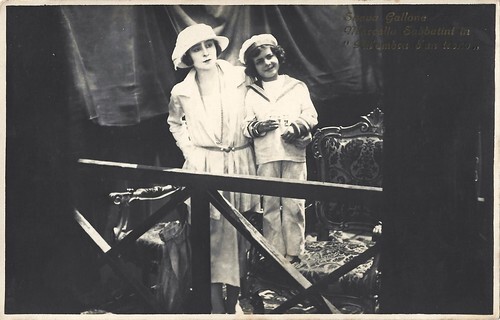
Italian postcard by G. B. Falci, Milano, no. 115. Photo: Films Gallone. Soava Gallone and Marcella Sabbatini in All'ombra di un trono/L'Ombra di un tron/In the Shadow of a Throne(Carmine Gallone, 1921), based on a novel by Charles Folly, 'Fleur d'ombre'.
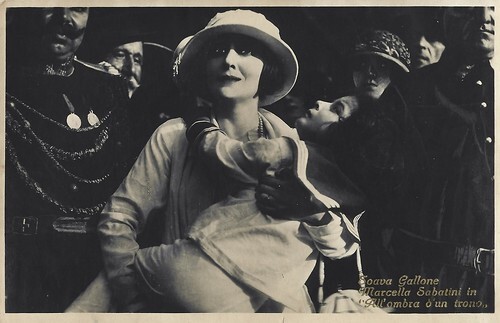
Italian postcard by G. B. Falci, Milano, no. 117. Photo: Films Gallone. Soava Gallone and Marcella Sabbatini in All'ombra di un trono/L'Ombra di un tron/In the Shadow of a Throne(Carmine Gallone, 1921).
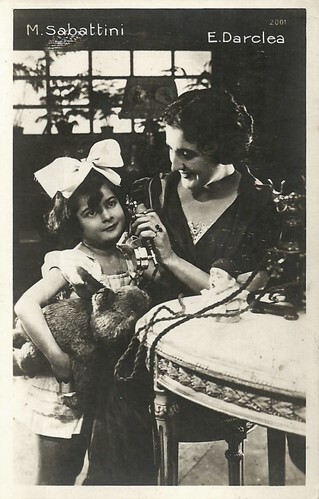
Italian postcard by Vettori, Bologna, no. 2001. Marcella Sabbatini and Edy Darclea in La valse ardente/The Fiery Waltz (Torello Rolli, 1921).
The little son of Domitilla
From 1920, Marcella Sabbatini often acted as the child of the Italian divas. She was the daughter of Francesca Bertini in La ferita/The Wound (Roberto Roberti, 1920) and L'ultimo sogno/The Last Dream (Roberto Roberti 1921). Pina Menichelli was her mother in La donna e l'uomo/Woman and Man (Amleto Palermi 1923) and Soava Gallone in All'ombra di un trono/L'Ombra di un tron/In the Shadow of a Throne (Carmine Gallone, 1921), and La cavalcata ardente/The Fiery Ride (Carmine Gallone, 1925). She was the child of Maria Jacobini in La casa sotto la neve/Under the Snow (Gennaro Righelli, 1922 and La bocca chiusa/The Closed Mouth (Guglielmo Zorzi, 1925).
Marcella Sabbatini also played the child of lesser female stars such as Edy Darclea in La valse ardente/The Fiery Waltz (Torello Rolli, 1921) and Enna Saredo in La figlia della tempesta/The Daughter of the Storm (Carmine Gallone, 1921), Il dubbio/The Doubt (Edoardo Bencivenga, 1921), Le due madri/The Two Mothers (Torello Rolli, 1922) and Le vie del mare/The Ways of the Sea (Torello Rolli, 1923). In 1923 Bonnard directed her again in La maschera che ride/The Laughing Mask and Il trittico/The Triptych.
In the late silent epic Quo vadis? (Gabriellino D'Annunzio, Georg Jacoby, 1924) starring Emil Jannings as Nero. Sabbatini played the little son [!] of Domitilla ( Elga Brink ).
In the mid-1920s, Sabbatini played opposite Rina De Liguoro in the rural drama Maremma (Salvatore Aversano, 1924) and in the De Amicis adaptation Il focolare spento/The Unlit Hearth (Augusto Genina, 1925). However, the lead in the latter film was for rising star and Genina's then-girlfriend Carmen Boni . In 1926, Washington Borg entrusted her with the lead role in the film Mi chiamano Mimì/They call me Mimì (1929), for which she received good critical acclaim, although it was her last silent film.
Sabbatini's last film was Perché no?/The Lady Lies (1930), directed by Amleto Palermi, the first of the films made by the American company Paramount for Italian cinema. The sound film was shot in the Joinville factory in France. Having abandoned show business, Marcella retired to private life. She married Alfredo Tentoni, a musician born into a family of musicians, with whom she had two sons, Fabrizio (1938) and Piero (1942). Marcella Sabbatini died in Rome, in 2001, at 86.
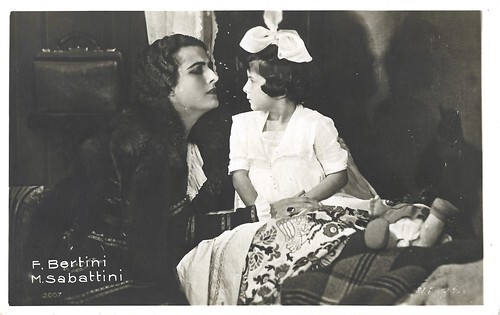
Italian postcard by Ed. Vettori, Bologna, no. 2007. Francesca Bertini and Marcella Sabbatini, possibly in La ferita/The Wound (Roberto Roberti, 1920). They also played together in L'ultimo sogno/The Last Dream (Roberto Roberti, 1921).
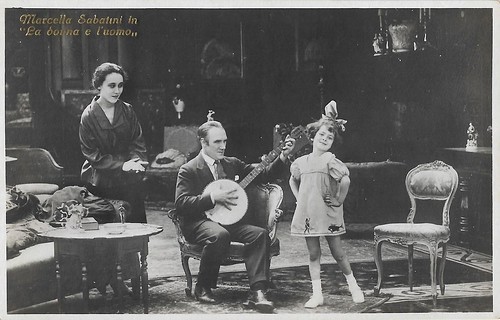
Italian postcard by Ed. G.B. Falci, Milano. Photo: Rinascimento Film / UCI. Milton Rosmer and Marcella Sabbatini in La donna e l'uomo/Woman and Man (Amleto Palermi, 1923). The woman is unknown.
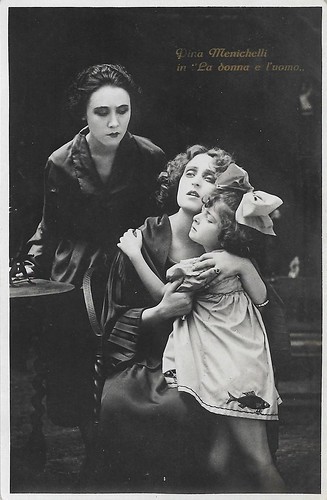
Italian postcard by G.B. Falci, Milano. Photo: Fotominio. Pina Menichelli and Marcella Sabbatini in La donna e l'uomo/Woman and Man (Amleto Palermi, 1923).
Sources: Wikipedia (Italian), and .

Italian postcard by Vettori, Bologna, no. 1026. "La più piccola Attrice Cinematografica" (The youngest film actress). Sabbatini's name is misspelled here as Sabattini.

Italian postcard by G.B. Falci, Milano. Photo: Fotominio. Pina Menichelli , Milton Rosmer and Marcella Sabbatini in La donna e l'uomo/Woman and Man (Amleto Palermi, 1923).

Italian postcard by Edizione L'Argentografica, Torino, no. 3049. Lillian Hall-Davis as Lygia/Licia, Alphons Fryland as Vinicius and Marcella Sabbatini as the son of Domitilla and Plautus the Italo-German epic Quo Vadis? (Gabriellino D'Annunzio, Georg Jacoby, 1924), one of the many adaptations of the classic novel by Henryk Sienkiewicz.
A celebrated child actress in Italian silent films
Marcella Sabbatini was born in Rome in 1914 into a family of revue and operetta actors. She made her film debut in 1919, while still a child, in a film by Celio. In addition to numerous films, she was portrayed, alone and with actresses such as Pina Menichelli in a series of postcards with publicity photos.
Her career took off and between 1919 and 1926 she became a celebrated child actress in Italian silent films, with over thirty films, gaining child star status. In 1919, she made her film debut in Mario Bonnard 's Germana, with Maria Caserini and Mina D'Orvella. She remained with Bonnard in several subsequent films, including Per un figlio (1920), again with Caserini and D'Orvella, followed by Papa Lebonard (1920) with Ugo Piperno in the title role.
Together with Ettore Casarotti, the duo Arnold and Patata (Aldo Mezzanotte), Franco Cappelli and Mimmo Palermi, Sabbatini was part of a new generation of Italian child actors who had established themselves in those years, before the crisis in Italian film production, with the bankruptcy of the U.C.I., interrupted their careers.
In 1921 Mario Bonnard cast her in the lead role in a re-edition of the film L'amor mio non muore, in which he had starred in 1913. The cast was composed entirely of child actors under the direction of Wladimiro Apolloni.
In addition to Bonnard, the young actress also worked several times with director Herbert Brenon at La principessa misteriosa (1920), Beatrice (1921) and Il colchico e la rosa (1921). All three films were shot in Italy and starred Marie Doro. She also acted in Jacques Creusy's Liberazione (1920), with Renée Pilar, and I dannati (1921) with Linda Pini .

Italian postcard by G. B. Falci, Milano, no. 115. Photo: Films Gallone. Soava Gallone and Marcella Sabbatini in All'ombra di un trono/L'Ombra di un tron/In the Shadow of a Throne(Carmine Gallone, 1921), based on a novel by Charles Folly, 'Fleur d'ombre'.

Italian postcard by G. B. Falci, Milano, no. 117. Photo: Films Gallone. Soava Gallone and Marcella Sabbatini in All'ombra di un trono/L'Ombra di un tron/In the Shadow of a Throne(Carmine Gallone, 1921).

Italian postcard by Vettori, Bologna, no. 2001. Marcella Sabbatini and Edy Darclea in La valse ardente/The Fiery Waltz (Torello Rolli, 1921).
The little son of Domitilla
From 1920, Marcella Sabbatini often acted as the child of the Italian divas. She was the daughter of Francesca Bertini in La ferita/The Wound (Roberto Roberti, 1920) and L'ultimo sogno/The Last Dream (Roberto Roberti 1921). Pina Menichelli was her mother in La donna e l'uomo/Woman and Man (Amleto Palermi 1923) and Soava Gallone in All'ombra di un trono/L'Ombra di un tron/In the Shadow of a Throne (Carmine Gallone, 1921), and La cavalcata ardente/The Fiery Ride (Carmine Gallone, 1925). She was the child of Maria Jacobini in La casa sotto la neve/Under the Snow (Gennaro Righelli, 1922 and La bocca chiusa/The Closed Mouth (Guglielmo Zorzi, 1925).
Marcella Sabbatini also played the child of lesser female stars such as Edy Darclea in La valse ardente/The Fiery Waltz (Torello Rolli, 1921) and Enna Saredo in La figlia della tempesta/The Daughter of the Storm (Carmine Gallone, 1921), Il dubbio/The Doubt (Edoardo Bencivenga, 1921), Le due madri/The Two Mothers (Torello Rolli, 1922) and Le vie del mare/The Ways of the Sea (Torello Rolli, 1923). In 1923 Bonnard directed her again in La maschera che ride/The Laughing Mask and Il trittico/The Triptych.
In the late silent epic Quo vadis? (Gabriellino D'Annunzio, Georg Jacoby, 1924) starring Emil Jannings as Nero. Sabbatini played the little son [!] of Domitilla ( Elga Brink ).
In the mid-1920s, Sabbatini played opposite Rina De Liguoro in the rural drama Maremma (Salvatore Aversano, 1924) and in the De Amicis adaptation Il focolare spento/The Unlit Hearth (Augusto Genina, 1925). However, the lead in the latter film was for rising star and Genina's then-girlfriend Carmen Boni . In 1926, Washington Borg entrusted her with the lead role in the film Mi chiamano Mimì/They call me Mimì (1929), for which she received good critical acclaim, although it was her last silent film.
Sabbatini's last film was Perché no?/The Lady Lies (1930), directed by Amleto Palermi, the first of the films made by the American company Paramount for Italian cinema. The sound film was shot in the Joinville factory in France. Having abandoned show business, Marcella retired to private life. She married Alfredo Tentoni, a musician born into a family of musicians, with whom she had two sons, Fabrizio (1938) and Piero (1942). Marcella Sabbatini died in Rome, in 2001, at 86.

Italian postcard by Ed. Vettori, Bologna, no. 2007. Francesca Bertini and Marcella Sabbatini, possibly in La ferita/The Wound (Roberto Roberti, 1920). They also played together in L'ultimo sogno/The Last Dream (Roberto Roberti, 1921).

Italian postcard by Ed. G.B. Falci, Milano. Photo: Rinascimento Film / UCI. Milton Rosmer and Marcella Sabbatini in La donna e l'uomo/Woman and Man (Amleto Palermi, 1923). The woman is unknown.

Italian postcard by G.B. Falci, Milano. Photo: Fotominio. Pina Menichelli and Marcella Sabbatini in La donna e l'uomo/Woman and Man (Amleto Palermi, 1923).
Sources: Wikipedia (Italian), and .
Published on October 16, 2024 22:00
October 15, 2024
Ross Verlag, Part 6: Film-Foto-Verlag
Ross Verlag disappeared by the end of the war. The National Socialists had retained the name after they had forced Heinrich Ross out of his own company. But during the Second World War, they also started to use the name Film-Foto-Verlag. The design of the cards and the numbering system did not alter. After the war, the name Film-Foto-Verlag reappeared in the early 1950s for a short while, but it soon changed to UFA/Film-Foto. Here are 25 of our favourite Film-Foto-Verlag postcards.
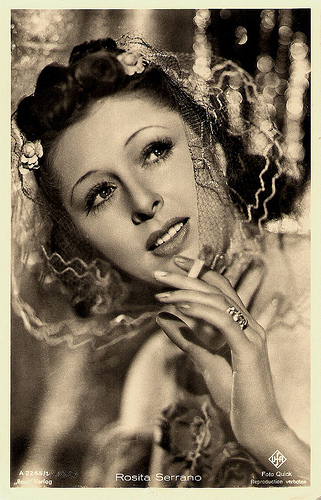
German postcard by Film-Foto-Verlag, no. A 2245/1, 1939-1940. Photo: Quick / Ufa. Rosita Serrano .
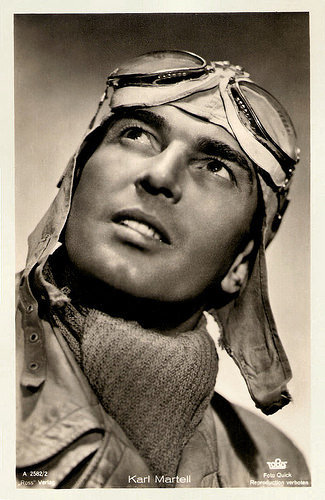
German postcard by Film-Foto-Verlag, no. A 2582/2, 1939-1940. Photo: Quick / Tobis. Karl Martell .
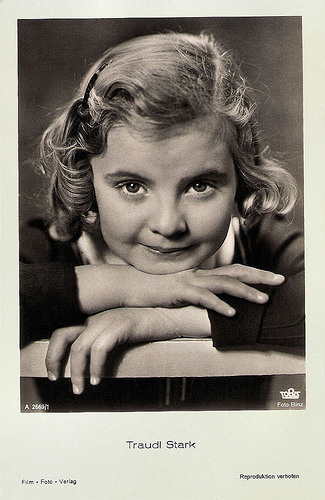
German Postcard by Film-Foto-Verlag, no. A 2669/1, 1939-1940. Photo: Tita Binz / Tobis. Traudl Stark .
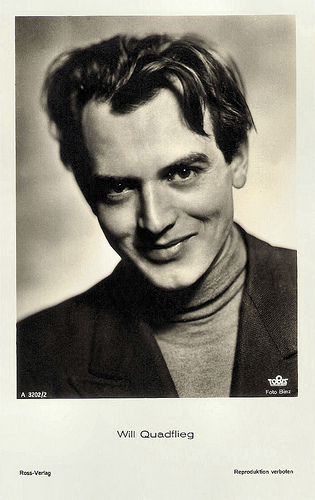
German postcard by Film-Foto-Verlag, no. A 3202/1, 1941-1944. Photo: Tita Binz / Tobis. Will Quadflieg .
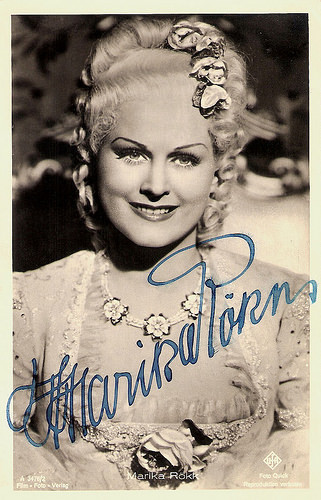
Marika Rökk in Tanz mit dem Kaiser/Dance With the Emperor (Georg Jacoby, 1941). German postcard by Film-Foto-Verlag, no. A 3478/2, 1941-1944. Photo: Quick / Ufa.
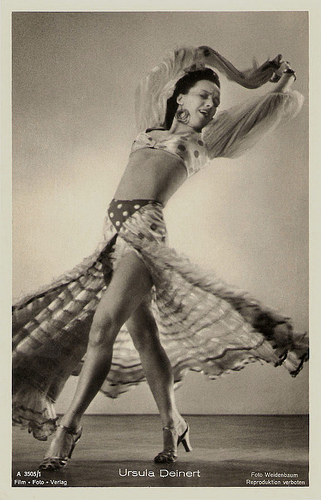
German postcard by Film-Foto-Verlag, no. A 3505/1, 1941-1944. Photo: Weidenbaum. Ursula Deinert .
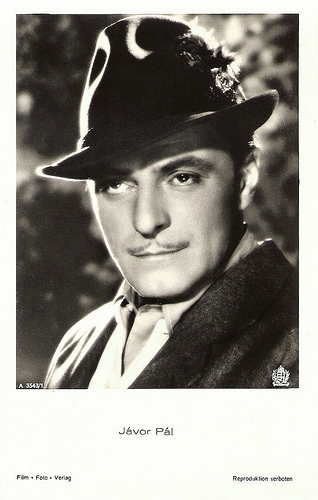
German postcard by Film-Foto-Verlag, no. A 3543/1. Pál Jávor .
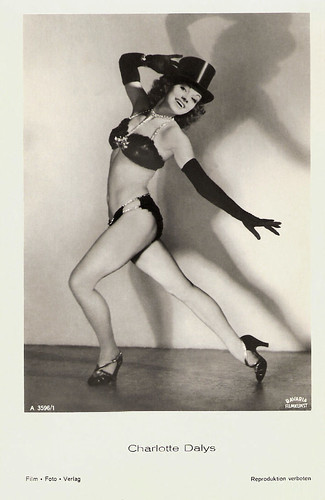
German Postcard by Film-Foto-Verlag, no. A 3596/1, 1941-1944. Photo: Bavaria Filmkunst. Charlotte Dalys.
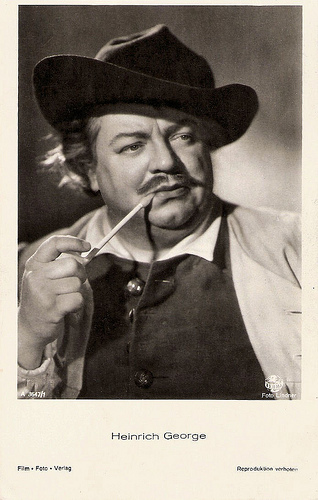
German postcard by Film-Foto-Verlag, no. 3647/1, 1941-1944. Photo: Lindner / Terra. Heinrich George in Andreas Schlüter (Herbert Maisch, 1942).
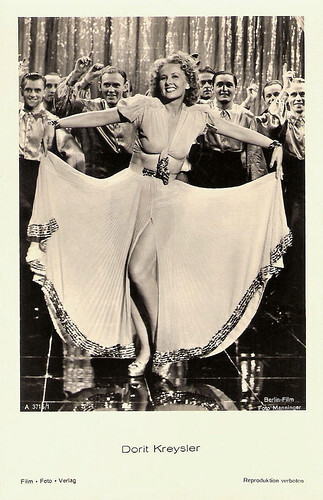
German postcard by Film-Foto-Verlag, no. A 3715/1, 1941-1944. Photo: Manninger / Berlin-Film. Dorit Kreysler .
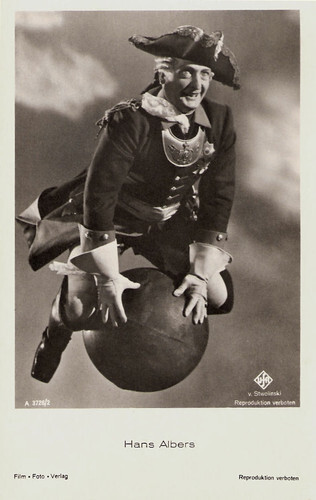
German postcard by Film-Foto-Verlag, no. A 3728/2, 1941-1944. Photo: von Stwolinski / Ufa. Hans Albers in Münchhausen/The Adventures of Baron Munchhausen (Josef von Baky, 1943).
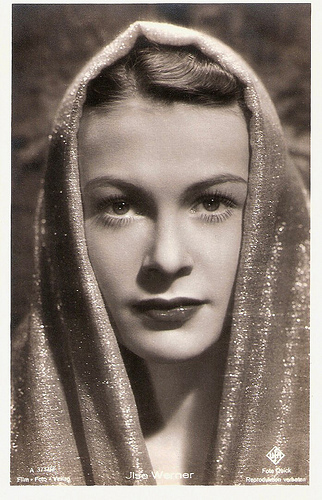
German postcard by Film-Foto-Verlag, no. A 3732/2, 1941-1944. Photo: Quick / Ufa. Ilse Werner .
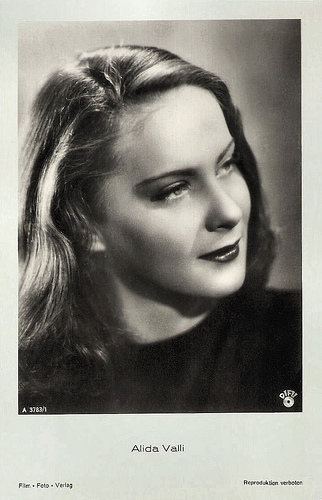
German postcard by Film-Foto-Verlag, no. A 3783/1, 1941-1944. Photo: DIFU. Alida Valli .
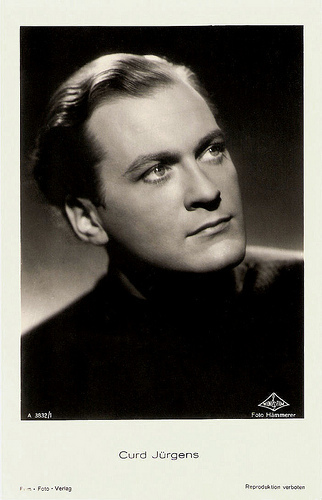
German postcard by Film-Foto-Verlag, no. A 3832/1, 1941-1944. Photo: Hämmerer / Wien Film. Curd Jürgens .
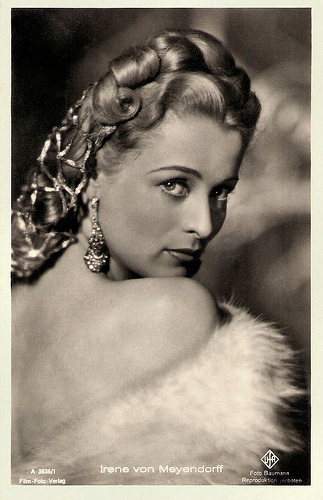
German postcard by Film-Foto-Verlag, no. A 3836/1, 1941-1944. Photo: Baumann / Ufa. Irene von Meyendorff .
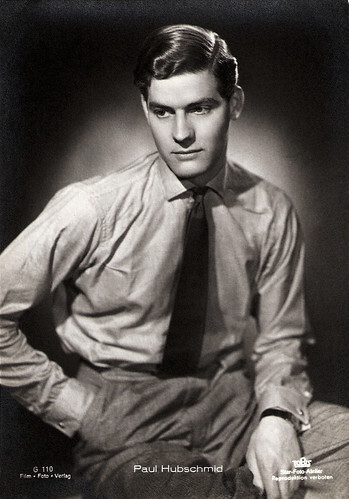
German postcard by Film-Foto-Verlag, no. G 110, 1941-1944. Photo: Star-Foto-Atelier / Tobis. Paul Hubschmid .
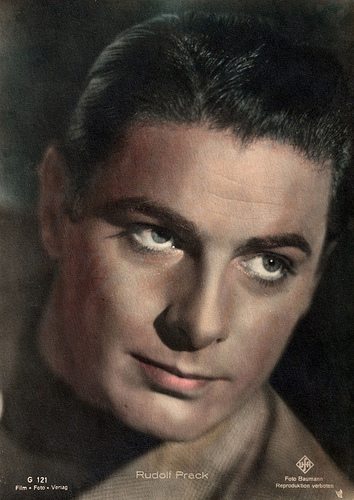
German Postcard by Film-Foto-Verlag, no. G 121. Photo: Baumann / Ufa. Rudolf Prack .
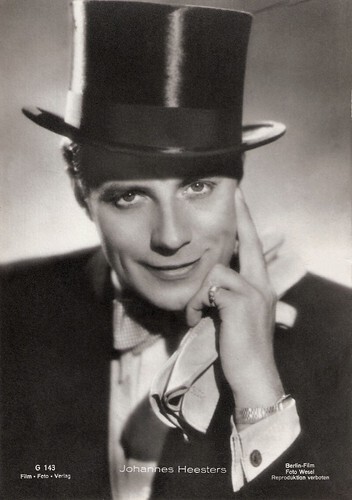
German postcard by Film-Foto-Verlag, G 143, 1941-1944. Photo: Berlin-Film / Wesel. Johannes Heesters .
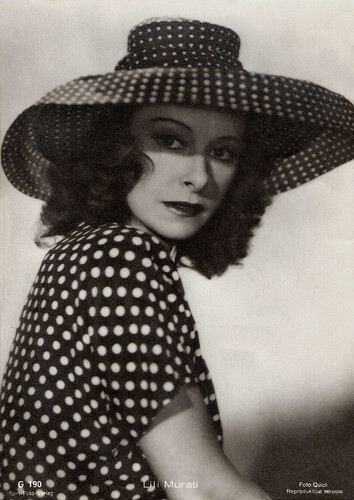
German postcard by Film-Foto-Verlag, no. G 190. Photo: Quick. Lili Muráti .
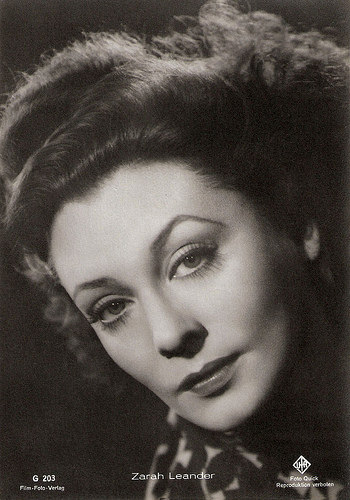
German postcard by Film-Foto-Verlag, no. G 203, 1941-1944. Photo: Quick / Ufa. Zarah Leander .
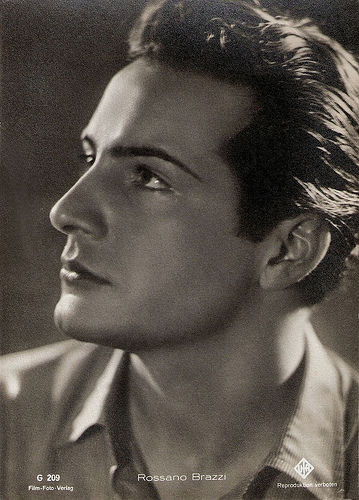
German postcard by Film-Foto-Verlag, no. G 209, 1941-1944. Photo: Ufa. Rossano Brazzi.
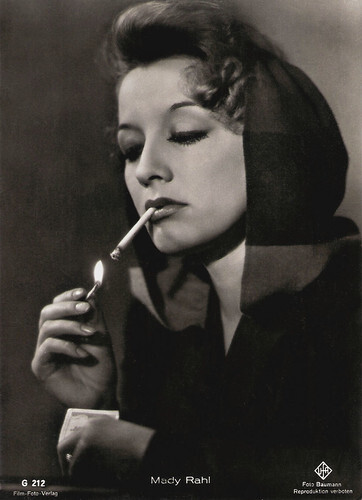
German postcard by Film-Foto-Verlag, no. G 212, 1941-1944. Photo: Baumann / Ufa. Mady Rahl .
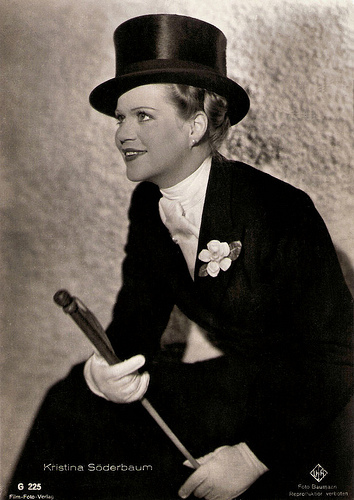
German postcard by Film-Foto-Verlag, no. G 225, 1941-1944. Photo: Baumann / Ufa. Kristina Söderbaum .
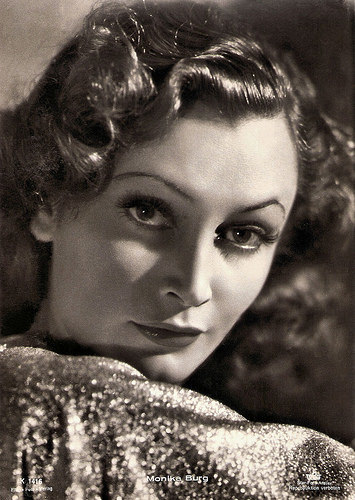
German Postcard by Film-Foto-Verlag, no. K 1416. Photo: Star-Foto-Atelier / Tobis. Monika Burg .
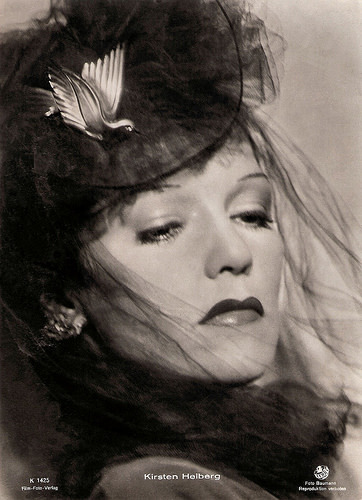
German postcard by Film-Foto-Verlag, no. K 1425. Photo: Baumann / Terra. Kirsten Heiberg .
Our Ross Verlag Tribute will be continued next week. And please, check out the Ross Verlag Movie Stars Postcards website.

German postcard by Film-Foto-Verlag, no. A 2245/1, 1939-1940. Photo: Quick / Ufa. Rosita Serrano .

German postcard by Film-Foto-Verlag, no. A 2582/2, 1939-1940. Photo: Quick / Tobis. Karl Martell .

German Postcard by Film-Foto-Verlag, no. A 2669/1, 1939-1940. Photo: Tita Binz / Tobis. Traudl Stark .

German postcard by Film-Foto-Verlag, no. A 3202/1, 1941-1944. Photo: Tita Binz / Tobis. Will Quadflieg .

Marika Rökk in Tanz mit dem Kaiser/Dance With the Emperor (Georg Jacoby, 1941). German postcard by Film-Foto-Verlag, no. A 3478/2, 1941-1944. Photo: Quick / Ufa.

German postcard by Film-Foto-Verlag, no. A 3505/1, 1941-1944. Photo: Weidenbaum. Ursula Deinert .

German postcard by Film-Foto-Verlag, no. A 3543/1. Pál Jávor .

German Postcard by Film-Foto-Verlag, no. A 3596/1, 1941-1944. Photo: Bavaria Filmkunst. Charlotte Dalys.

German postcard by Film-Foto-Verlag, no. 3647/1, 1941-1944. Photo: Lindner / Terra. Heinrich George in Andreas Schlüter (Herbert Maisch, 1942).

German postcard by Film-Foto-Verlag, no. A 3715/1, 1941-1944. Photo: Manninger / Berlin-Film. Dorit Kreysler .

German postcard by Film-Foto-Verlag, no. A 3728/2, 1941-1944. Photo: von Stwolinski / Ufa. Hans Albers in Münchhausen/The Adventures of Baron Munchhausen (Josef von Baky, 1943).

German postcard by Film-Foto-Verlag, no. A 3732/2, 1941-1944. Photo: Quick / Ufa. Ilse Werner .

German postcard by Film-Foto-Verlag, no. A 3783/1, 1941-1944. Photo: DIFU. Alida Valli .

German postcard by Film-Foto-Verlag, no. A 3832/1, 1941-1944. Photo: Hämmerer / Wien Film. Curd Jürgens .

German postcard by Film-Foto-Verlag, no. A 3836/1, 1941-1944. Photo: Baumann / Ufa. Irene von Meyendorff .

German postcard by Film-Foto-Verlag, no. G 110, 1941-1944. Photo: Star-Foto-Atelier / Tobis. Paul Hubschmid .

German Postcard by Film-Foto-Verlag, no. G 121. Photo: Baumann / Ufa. Rudolf Prack .

German postcard by Film-Foto-Verlag, G 143, 1941-1944. Photo: Berlin-Film / Wesel. Johannes Heesters .

German postcard by Film-Foto-Verlag, no. G 190. Photo: Quick. Lili Muráti .

German postcard by Film-Foto-Verlag, no. G 203, 1941-1944. Photo: Quick / Ufa. Zarah Leander .

German postcard by Film-Foto-Verlag, no. G 209, 1941-1944. Photo: Ufa. Rossano Brazzi.

German postcard by Film-Foto-Verlag, no. G 212, 1941-1944. Photo: Baumann / Ufa. Mady Rahl .

German postcard by Film-Foto-Verlag, no. G 225, 1941-1944. Photo: Baumann / Ufa. Kristina Söderbaum .

German Postcard by Film-Foto-Verlag, no. K 1416. Photo: Star-Foto-Atelier / Tobis. Monika Burg .

German postcard by Film-Foto-Verlag, no. K 1425. Photo: Baumann / Terra. Kirsten Heiberg .
Our Ross Verlag Tribute will be continued next week. And please, check out the Ross Verlag Movie Stars Postcards website.
Published on October 15, 2024 22:00
October 14, 2024
Ich will nicht wissen wer du bist (1932)
Liane Haid, Gustav Fröhlich and Szöke Szakáll were the stars of the delightful romantic comedy Ich will nicht wissen, wer du bist/I Don't Want To Know Who You Are (1932), scripted by Ernst Marischka and Robert Weil and directed by Géza von Bolváry. A year later, Szakall but also Fröhlich's wife and daughter had to go into exile because of the rise of Adolf Hitler and the Nazi Party. The rise of the fascists also ended the careers of the Jewish publishers of the postcards in this post, Heinrich Ross of Ross Verlag and Joseph Peter Welker of JosPe.
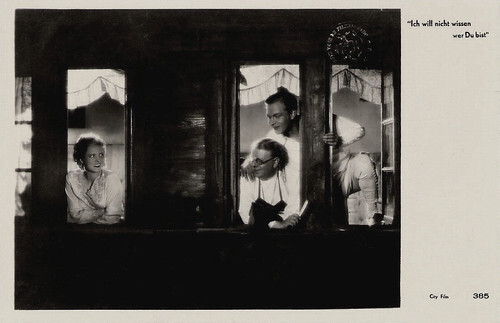
Dutch postcard by JosPe, Arnhem, no. 385. Photo: City Film. Liane Haid , Gustav Fröhlich and Szöke Szakáll in Ich will nicht wissen, wer du bist/I Don't Want To Know Who You Are (Géza von Bolváry, 1932).
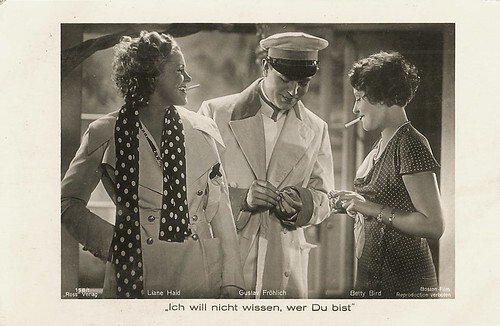
German postcard by Ross Verlag, no. 158/1. Photo: Boston-Film. Gustav Fröhlich , Liane Haid and Betty Bird in Ich will nicht wissen, wer du bist/I Don't Want To Know Who You Are (Géza von Bolváry, 1932).
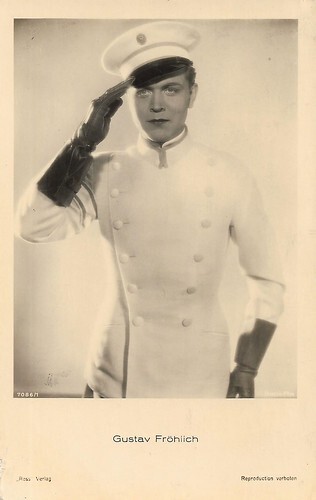
German postcard by Ross Verlag. no. 7086/1, 1932-1933. Photo: Boston-Film. Gustav Fröhlich in Ich will nicht wissen, wer du bist/I Don't Want to Know Who You Are (Géza von Bolváry, 1932).
A comedy of mistaken identities
Ich will nicht wissen, wer du bist/I Don't Want To Know Who You Are (Géza von Bolváry, 1932) is a comedy of mistaken identities, written by Ernst Marischka and Robert Weil.
The penniless Count Lerchenau ( Gustav Fröhlich ) has to work as a chauffeur under the name Robert Lindt. However, he lost his last job, because women love him so much.
His former servant Ottokar (Szöke Szakall) remains loyal to him and tries to get him to marry a rich woman. However, at the restaurant where he is supposed to meet a suitable lady, R, he ends up flirting with the attractive Alice ( Liane Haid ) instead.
Robert gives Count Lerchenau as a reference to get a job on President Fuhring's (Max Güllstorff) staff. But then Führing wants to speak to Lerchenau, and Franz has to play the role of the count...
Alice, it turns out, is Führing's niece. When she learns that Robert is only a chauffeur, she wants nothing more to do with him. But after all sorts of turbulence, they find each other after all.
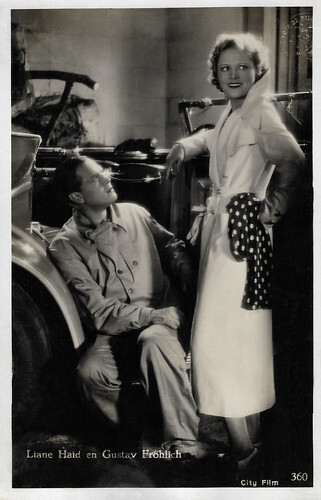
Dutch postcard, no. 360. Photo: City Film. Liane Haid and Gustav Fröhlich in Ich will nicht wissen, wer du bist (Géza von Bolváry, 1932). The mark on the right side of the card refers to the Dutch censorship approval.
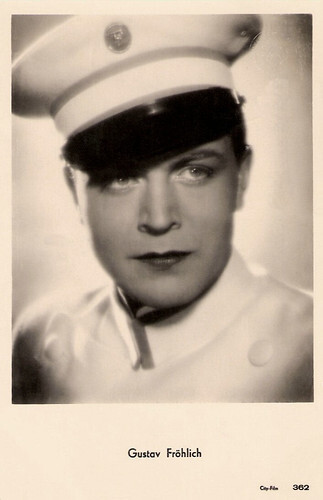
Dutch Postcard, no. 362. Photo: City Film. Gustav Fröhlich in Ich will nicht wissen, wer du bist/I Don't Want To Know Who You Are (Géza von Bolváry, 1932).
Because of the regime, because everything was bombed, and because all the good directors had left
The male star of Ich will nicht wissen, wer du bist/I Don't Want To Know Who You Are (Géza von Bolváry, 1932) was Gustav Fröhlich , who had his breaktrhough as Freder Fredersen in Metropolis (Fritz Lang, 1927). Fröhlich often played smart gentlemen in lighthearted musicals and romances. Because of his carefree attendance, Fröhlich was seldom allowed to play other characters. He frequently worked with Hungarian film director Géza von Bolváry, who specialised in Viennese Operettas and romantic comedies. Between 1931 and 1933 they made six films together. These include Liebeskommando/Love's Command (Géza von Bolváry, 1931), Ich will nicht wissen, wer du bist/I Do Not Want to Know Who You Are (Géza von Bolváry, 1932), and Was Frauen träumen/What Women Dream (Géza von Bolváry, 1933), which was co-written by Billy Wilder .
In 1931, Fröhlich married Hungarian opera star and actress Gitta Alpár , with whom he had a child, Julika. Alpar was Jewish and the rise to power of Adolf Hitler in 1933 destroyed her successful film career in Germany. Mother and child were forced to leave Germany and fled to the U.S. Fröhlich distanced from his wife because he didn't want to endanger his career. During the Third Reich, he remained one of the foremost German film stars. Their marriage was dissolved in 1935 as 'illegal' in National Socialist Germany. After the war, Fróhlich tried to apologise for his behaviour but Alpár could not answer his pleas. A circumstance which, according to IMDb, gave Fröhlich a hard time in his last years and beclouded his lust for life.
Liane Haid was the first Austrian movie star in film history. She already appeared in operas and operettas before she made her first film appearance. Very popular were her silent film operettas Im weißen Rößl/The White Horse Inn (Richard Oswald, 1926) and Die Csardasfürstin/The Csardas Princess (Hanns Schwarz, 1927). The transition to sound film, which required a different way of acting, she mastered very well. In the hit film Das Lied ist aus/The Song Is Over (Géza von Bolváry, 1930), she sang the song that became famous: 'Adieu mein kleine Gardeoffizier' composed by Robert Stolz. Haid was at the height of her popularity. In 1933 alone, she appeared in nine feature films. From the mid-1930s, she refused film offers and instead focused on her stage career. In 1942, she escaped from Nazi Germany to Switzerland in 1942 "because of the regime, because everything was bombed, and because all the good directors had left".
In the early 1930s, Hungarian actor Szöke Szakall was, next to Hans Moser , the most significant representative of the Wiener Film, the Viennese light romantic comedy genre. Among his German films was Géza von Bolváry's Zwei Herzen im 3/4 Takt/Two Hearts in Waltz Time (1930). The Jewish Szákall was forced to return to Hungary, because of the rise of Adolf Hitler and the Nazi movement. He was involved in over 40 films in his native land, including Skandal in Budapest/Romance in Budapest (Steve Sekely, Géza von Bolváry, 1933). When Hungary joined the Axis in 1940, he went into exile with his wife and became famous in Hollywood as S.Z Sakall . Many of Szákall's close relatives later died in Nazi concentration camps, including all three of his sisters and his niece, as well as his wife's brother and sister.
The sets of Ich will nicht wissen, wer du bist/I Don't Want To Know Who You Are were designed by the art director Franz Schroedter. The music was by Robert Stolz. The title song 'Ich will nicht wissen wer du bist', composed by Stolz with lyrics by Ernst Marischka, was sung by Liane Haid . In the cast were also Adele Sandrock as Emerenzia, Betty Bird as Käthe, her niece, Julius E. Herrmann as Councillor of Commerce Blume, and Lotte Lorring as his wife Helga. At VPRO , the reviewer writes: 'An upbeat film operetta with very nice songs by Robert Stolz and fine roles by Liane Haid and Gustav Fröhlich . In 1942, scriptwriter Ernst Marischka directed a remake of the film, Abenteuer im Grandhotel/Adventures in the Grand Hotel (Ernst Marischka, 1942) with Wolf Albach-Retty and Carola Höhn . Hans Moser now played the role of Szöke Szakall .
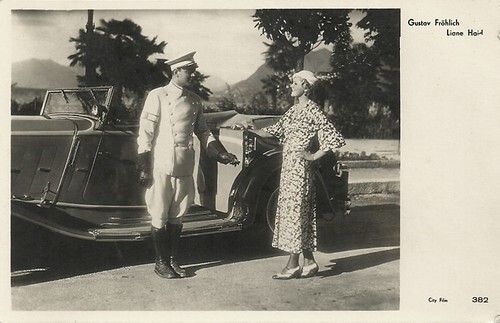
Dutch Postcard, no. 382. Photo: City Film. Liane Haid and Gustav Fröhlich in Ich will nicht wissen, wer du bist/I Don't Want To Know Who You Are (Géza von Bolváry, 1932).
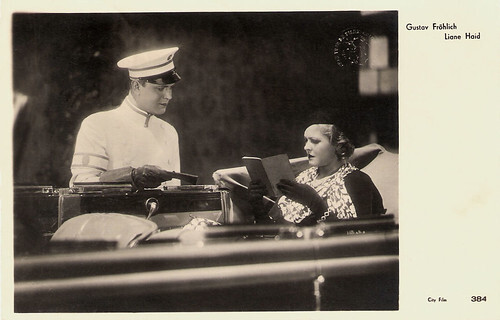
Dutch postcard by JosPe, Arnhem, no. 384. Photo: City Film. Liane Haid and Gustav Fröhlich in Ich will nicht wissen, wer du bist/I Don't Want To Know Who You Are (Géza von Bolváry, 1932).
Source: VPRO (Dutch), Filmportal (German), Wikipedia (English) and IMDb.

Dutch postcard by JosPe, Arnhem, no. 385. Photo: City Film. Liane Haid , Gustav Fröhlich and Szöke Szakáll in Ich will nicht wissen, wer du bist/I Don't Want To Know Who You Are (Géza von Bolváry, 1932).

German postcard by Ross Verlag, no. 158/1. Photo: Boston-Film. Gustav Fröhlich , Liane Haid and Betty Bird in Ich will nicht wissen, wer du bist/I Don't Want To Know Who You Are (Géza von Bolváry, 1932).

German postcard by Ross Verlag. no. 7086/1, 1932-1933. Photo: Boston-Film. Gustav Fröhlich in Ich will nicht wissen, wer du bist/I Don't Want to Know Who You Are (Géza von Bolváry, 1932).
A comedy of mistaken identities
Ich will nicht wissen, wer du bist/I Don't Want To Know Who You Are (Géza von Bolváry, 1932) is a comedy of mistaken identities, written by Ernst Marischka and Robert Weil.
The penniless Count Lerchenau ( Gustav Fröhlich ) has to work as a chauffeur under the name Robert Lindt. However, he lost his last job, because women love him so much.
His former servant Ottokar (Szöke Szakall) remains loyal to him and tries to get him to marry a rich woman. However, at the restaurant where he is supposed to meet a suitable lady, R, he ends up flirting with the attractive Alice ( Liane Haid ) instead.
Robert gives Count Lerchenau as a reference to get a job on President Fuhring's (Max Güllstorff) staff. But then Führing wants to speak to Lerchenau, and Franz has to play the role of the count...
Alice, it turns out, is Führing's niece. When she learns that Robert is only a chauffeur, she wants nothing more to do with him. But after all sorts of turbulence, they find each other after all.

Dutch postcard, no. 360. Photo: City Film. Liane Haid and Gustav Fröhlich in Ich will nicht wissen, wer du bist (Géza von Bolváry, 1932). The mark on the right side of the card refers to the Dutch censorship approval.

Dutch Postcard, no. 362. Photo: City Film. Gustav Fröhlich in Ich will nicht wissen, wer du bist/I Don't Want To Know Who You Are (Géza von Bolváry, 1932).
Because of the regime, because everything was bombed, and because all the good directors had left
The male star of Ich will nicht wissen, wer du bist/I Don't Want To Know Who You Are (Géza von Bolváry, 1932) was Gustav Fröhlich , who had his breaktrhough as Freder Fredersen in Metropolis (Fritz Lang, 1927). Fröhlich often played smart gentlemen in lighthearted musicals and romances. Because of his carefree attendance, Fröhlich was seldom allowed to play other characters. He frequently worked with Hungarian film director Géza von Bolváry, who specialised in Viennese Operettas and romantic comedies. Between 1931 and 1933 they made six films together. These include Liebeskommando/Love's Command (Géza von Bolváry, 1931), Ich will nicht wissen, wer du bist/I Do Not Want to Know Who You Are (Géza von Bolváry, 1932), and Was Frauen träumen/What Women Dream (Géza von Bolváry, 1933), which was co-written by Billy Wilder .
In 1931, Fröhlich married Hungarian opera star and actress Gitta Alpár , with whom he had a child, Julika. Alpar was Jewish and the rise to power of Adolf Hitler in 1933 destroyed her successful film career in Germany. Mother and child were forced to leave Germany and fled to the U.S. Fröhlich distanced from his wife because he didn't want to endanger his career. During the Third Reich, he remained one of the foremost German film stars. Their marriage was dissolved in 1935 as 'illegal' in National Socialist Germany. After the war, Fróhlich tried to apologise for his behaviour but Alpár could not answer his pleas. A circumstance which, according to IMDb, gave Fröhlich a hard time in his last years and beclouded his lust for life.
Liane Haid was the first Austrian movie star in film history. She already appeared in operas and operettas before she made her first film appearance. Very popular were her silent film operettas Im weißen Rößl/The White Horse Inn (Richard Oswald, 1926) and Die Csardasfürstin/The Csardas Princess (Hanns Schwarz, 1927). The transition to sound film, which required a different way of acting, she mastered very well. In the hit film Das Lied ist aus/The Song Is Over (Géza von Bolváry, 1930), she sang the song that became famous: 'Adieu mein kleine Gardeoffizier' composed by Robert Stolz. Haid was at the height of her popularity. In 1933 alone, she appeared in nine feature films. From the mid-1930s, she refused film offers and instead focused on her stage career. In 1942, she escaped from Nazi Germany to Switzerland in 1942 "because of the regime, because everything was bombed, and because all the good directors had left".
In the early 1930s, Hungarian actor Szöke Szakall was, next to Hans Moser , the most significant representative of the Wiener Film, the Viennese light romantic comedy genre. Among his German films was Géza von Bolváry's Zwei Herzen im 3/4 Takt/Two Hearts in Waltz Time (1930). The Jewish Szákall was forced to return to Hungary, because of the rise of Adolf Hitler and the Nazi movement. He was involved in over 40 films in his native land, including Skandal in Budapest/Romance in Budapest (Steve Sekely, Géza von Bolváry, 1933). When Hungary joined the Axis in 1940, he went into exile with his wife and became famous in Hollywood as S.Z Sakall . Many of Szákall's close relatives later died in Nazi concentration camps, including all three of his sisters and his niece, as well as his wife's brother and sister.
The sets of Ich will nicht wissen, wer du bist/I Don't Want To Know Who You Are were designed by the art director Franz Schroedter. The music was by Robert Stolz. The title song 'Ich will nicht wissen wer du bist', composed by Stolz with lyrics by Ernst Marischka, was sung by Liane Haid . In the cast were also Adele Sandrock as Emerenzia, Betty Bird as Käthe, her niece, Julius E. Herrmann as Councillor of Commerce Blume, and Lotte Lorring as his wife Helga. At VPRO , the reviewer writes: 'An upbeat film operetta with very nice songs by Robert Stolz and fine roles by Liane Haid and Gustav Fröhlich . In 1942, scriptwriter Ernst Marischka directed a remake of the film, Abenteuer im Grandhotel/Adventures in the Grand Hotel (Ernst Marischka, 1942) with Wolf Albach-Retty and Carola Höhn . Hans Moser now played the role of Szöke Szakall .

Dutch Postcard, no. 382. Photo: City Film. Liane Haid and Gustav Fröhlich in Ich will nicht wissen, wer du bist/I Don't Want To Know Who You Are (Géza von Bolváry, 1932).

Dutch postcard by JosPe, Arnhem, no. 384. Photo: City Film. Liane Haid and Gustav Fröhlich in Ich will nicht wissen, wer du bist/I Don't Want To Know Who You Are (Géza von Bolváry, 1932).
Source: VPRO (Dutch), Filmportal (German), Wikipedia (English) and IMDb.
Published on October 14, 2024 22:00
October 13, 2024
Gardner McKay
American actor, artist, and author Gardner McKay (1932-2001) was best known for the lead role in the TV series Adventures in Paradise (1959-1962), based loosely on the writings of James Michener. He quit acting and became a writer in 1970.
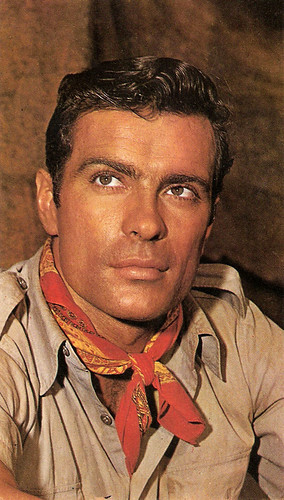
French postcard by Publistar, offered by Corvisart, Epinal, no. 919. Photo: United-Press.
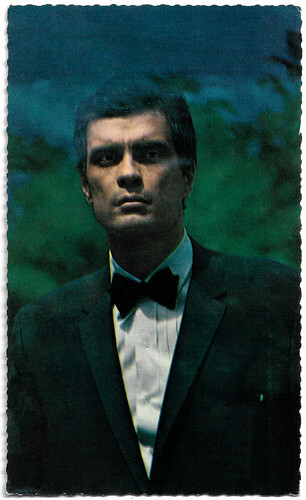
French postcard by Publistar, Marseille, for Corvisart, Epinal, no. 1120. Photo: Philippe d'Argence.
Man about town
George Cadogan Gardiner McKay was born in 1932 in New York City. 'Gard' was the son of ad executive Hugh Deane McKay and socialite Catherine 'Kitty' Gardner McKay. His father's business took the family to Paris, where McKay attended private schools. The family returned to the United States shortly before the outbreak of World War II.
McKay and his older brother, Hugh, lived with their grandparents in Lexington, Kentucky. He attended Cornell University in Ithaca, New York for two years, where he majored in art. He wrote for The Cornell Daily Sun and the campus magazine. He dropped out of school at the age of 19 following the death of his father and moved to Greenwich Village where he worked as a sculptor and writer.
McKay also took up photography and saw some of his work published in The New York Times and Life magazine. McKay's sculpting appeared in the Museum of Modern Art in New York, and at an exhibit of his work, McKay attracted the attention of photographer Richard Avedon. Avedon invited McKay to Paris to shoot a series of photographs with models Suzy Parker and Barbara Mullen, cavorting in Paris bistros and nightclubs. The photo series led to a modelling career.
Town and Country magazine did a piece on McKay and his sculptures in its 'Man About Town' section, which led to an offer from an agent. McKay impressed producer Dore Schary, who signed him to a contract with MGM. For that studio, he played in episodes of The Thin Man (1957) and appeared uncredited in the film Raintree County (Edward Dmytryk, 1957), with Elizabeth Taylor and Montgomery Clift .
McKay left MGM and had television guest roles on Death Valley Days (1958), The Silent Service (1958), and Jefferson Drum (1958). In 1957–1958, McKay played United States Army Lieutenant Dan Kelly in the 38-episode syndicated Western series Boots and Saddles, with co-stars Jack Pickard and Patrick McVey. At 20th Century Fox, he screen-tested for a TV series based on The Gunslinger but failed to get the role. The test did, however, net him a long-term contract at the studio.
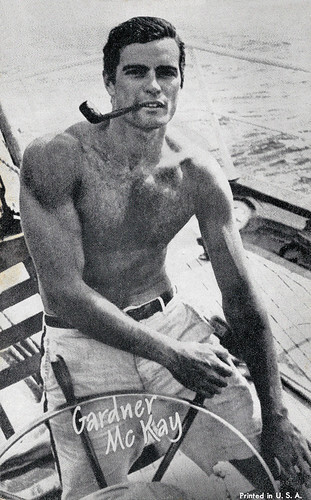
American Arcade postcard. Gardner McKay in Adventures in Paradise (1959-1962).
An extraordinarily handsome guy
Gardner McKay was spotted at the studio coffee shop by Dominick Dunne who was searching for an actor to star in his planned TV series Adventures in Paradise. Dunne later said, "I didn't know who he was. He was an extraordinarily handsome guy. I said, 'Are you an actor?' I gave him my card and said, 'If you're interested, call me.'"
McKay called, and ten actors were tested for the role. Dunne said of McKay: "His (test) was the worst, but everybody reacted to him, I mean everybody – especially the women." Although previously unknown to the public, McKay was featured on the cover of the 6 July 1959 issue of Life just two months before the series premiered. The article noted that he had been around boats since childhood and was an experienced seaman.
His character in Adventures in Paradise, Adam Troy, is a Korean War veteran who purchased the two-masted 82-foot (25 m) schooner Tiki III and sailed the South Pacific. The show ran for three seasons on ABC from 1959–1962, for a total of 91 episodes. During the series' run, McKay had bit roles in the Fox films Holiday for Lovers (Henry Levin, 1959) with Clifton Webb and The Right Approach (David Butler, 1961) starring Frankie Vaughan .
McKay returned to Hollywood in 1963 and had a support role in Fox's The Pleasure Seekers (Jean Negulesco, 1964) starring Ann-Margret . "It took me 100 hours to become a good actor," McKay later said. "Then I committed professional suicide." McKay had just decided to end his acting career, when he got a phone call from the noted director George Cukor, offering him the opportunity to star in a romantic comedy film opposite Marilyn Monroe .
The film was Something's Got to Give. McKay had made up his mind and turned it down. Cukor and Monroe were shocked. Monroe phoned him to see if she could get him to change his mind. McKay said, "She was so delightful on the phone, so winning, so seductive in a way," but he said no. He added, "I didn’t belong in acting." The part went to Dean Martin and the film was never completed. McKay's final film was I Sailed to Tahiti with an All Girl Crew (Richard L. Bare, 1968).
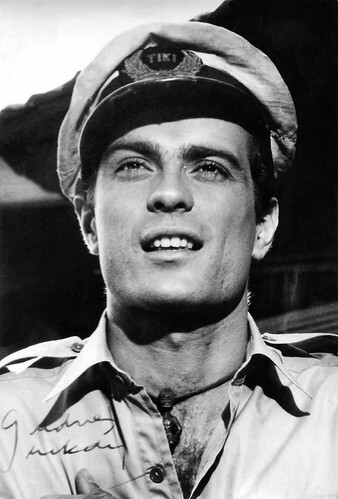
Vintage autograph card. Photo: Gardner McKay in Adventures in Paradise (1959-1962).
Leaving Hollywood
Gardner McKay sailed in the Caribbean and South America for a year and a half. "Not doing anything really," he said later. "I didn't give myself an excuse for being there." He moved to Paris, where he had lived as a boy. McKay left Hollywood to pursue his interest in photography, sculpture, and writing. Besides holding individual exhibitions, he exhibited his sculpture at the Museum of Modern Art in New York City.
His lifeboat rescue photographs of the Andrea Doria were published internationally. McKay wrote many plays and novels and was a literary critic for the Los Angeles Herald Examiner between 1977 and 1982. He taught writing classes at the University of California at Los Angeles, the University of Southern California, the University of Alaska, and the University of Hawaii.
He co-directed and wrote the TV film Me (Gardner McKay, Allan Muir, 1973) and wrote the script for another TV movie, Sea Marks (Ron Maxwell, Steven Robman, 1976), based on his play 'Sea Marks'. His play 'Toyer' was produced by the Arena Players Repertory Theater in New York in 1993 and in London at the Arts Theatre in 2009. Gardner bought a wooded property in Beverly Hills and kept a menagerie of animals including lions, cheetahs, dogs, and a monkey which he brought back from his sojourn to South America.
McKay's awards included three National Endowment for the Arts fellowships for playwriting, the Drama Critics Circle Award for Best Play, and the Sidney Carrington Prize. He was a winner of the Canadian Regional Drama Festival and runner-up in the Hemingway Short Story Contest. Gardner McKay settled in Hawaii, where he died in Honolulu from prostate cancer in 2001 at the age of 69.
He was survived by his wife since 1980, Madeleine Madigan, a painter, and two children, son Tristan and daughter Liza. Gardner is buried in Kentucky. Gardner Mckay is immortalised in the Jimmy Buffett song 'We Are the People Our Parents Warned Us About' (1983) that appeared on his 'One Particular Harbour' album with the line "Hey hey, Gardner McKay... Take us on the Leaky Tiki with you... Clear skies bound for Shanghai".
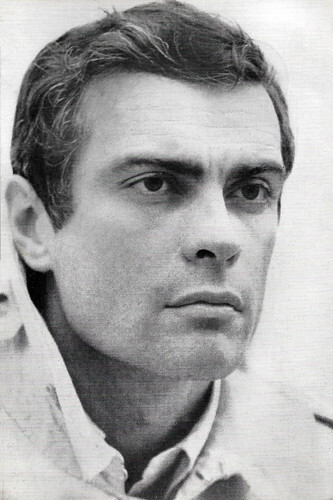
French promotion card. Photo: G. Neuvecelle / Columbia / EMI. Sent by mail from Martinique to France in 1965.
Sources: Wikipedia and .

French postcard by Publistar, offered by Corvisart, Epinal, no. 919. Photo: United-Press.

French postcard by Publistar, Marseille, for Corvisart, Epinal, no. 1120. Photo: Philippe d'Argence.
Man about town
George Cadogan Gardiner McKay was born in 1932 in New York City. 'Gard' was the son of ad executive Hugh Deane McKay and socialite Catherine 'Kitty' Gardner McKay. His father's business took the family to Paris, where McKay attended private schools. The family returned to the United States shortly before the outbreak of World War II.
McKay and his older brother, Hugh, lived with their grandparents in Lexington, Kentucky. He attended Cornell University in Ithaca, New York for two years, where he majored in art. He wrote for The Cornell Daily Sun and the campus magazine. He dropped out of school at the age of 19 following the death of his father and moved to Greenwich Village where he worked as a sculptor and writer.
McKay also took up photography and saw some of his work published in The New York Times and Life magazine. McKay's sculpting appeared in the Museum of Modern Art in New York, and at an exhibit of his work, McKay attracted the attention of photographer Richard Avedon. Avedon invited McKay to Paris to shoot a series of photographs with models Suzy Parker and Barbara Mullen, cavorting in Paris bistros and nightclubs. The photo series led to a modelling career.
Town and Country magazine did a piece on McKay and his sculptures in its 'Man About Town' section, which led to an offer from an agent. McKay impressed producer Dore Schary, who signed him to a contract with MGM. For that studio, he played in episodes of The Thin Man (1957) and appeared uncredited in the film Raintree County (Edward Dmytryk, 1957), with Elizabeth Taylor and Montgomery Clift .
McKay left MGM and had television guest roles on Death Valley Days (1958), The Silent Service (1958), and Jefferson Drum (1958). In 1957–1958, McKay played United States Army Lieutenant Dan Kelly in the 38-episode syndicated Western series Boots and Saddles, with co-stars Jack Pickard and Patrick McVey. At 20th Century Fox, he screen-tested for a TV series based on The Gunslinger but failed to get the role. The test did, however, net him a long-term contract at the studio.

American Arcade postcard. Gardner McKay in Adventures in Paradise (1959-1962).
An extraordinarily handsome guy
Gardner McKay was spotted at the studio coffee shop by Dominick Dunne who was searching for an actor to star in his planned TV series Adventures in Paradise. Dunne later said, "I didn't know who he was. He was an extraordinarily handsome guy. I said, 'Are you an actor?' I gave him my card and said, 'If you're interested, call me.'"
McKay called, and ten actors were tested for the role. Dunne said of McKay: "His (test) was the worst, but everybody reacted to him, I mean everybody – especially the women." Although previously unknown to the public, McKay was featured on the cover of the 6 July 1959 issue of Life just two months before the series premiered. The article noted that he had been around boats since childhood and was an experienced seaman.
His character in Adventures in Paradise, Adam Troy, is a Korean War veteran who purchased the two-masted 82-foot (25 m) schooner Tiki III and sailed the South Pacific. The show ran for three seasons on ABC from 1959–1962, for a total of 91 episodes. During the series' run, McKay had bit roles in the Fox films Holiday for Lovers (Henry Levin, 1959) with Clifton Webb and The Right Approach (David Butler, 1961) starring Frankie Vaughan .
McKay returned to Hollywood in 1963 and had a support role in Fox's The Pleasure Seekers (Jean Negulesco, 1964) starring Ann-Margret . "It took me 100 hours to become a good actor," McKay later said. "Then I committed professional suicide." McKay had just decided to end his acting career, when he got a phone call from the noted director George Cukor, offering him the opportunity to star in a romantic comedy film opposite Marilyn Monroe .
The film was Something's Got to Give. McKay had made up his mind and turned it down. Cukor and Monroe were shocked. Monroe phoned him to see if she could get him to change his mind. McKay said, "She was so delightful on the phone, so winning, so seductive in a way," but he said no. He added, "I didn’t belong in acting." The part went to Dean Martin and the film was never completed. McKay's final film was I Sailed to Tahiti with an All Girl Crew (Richard L. Bare, 1968).

Vintage autograph card. Photo: Gardner McKay in Adventures in Paradise (1959-1962).
Leaving Hollywood
Gardner McKay sailed in the Caribbean and South America for a year and a half. "Not doing anything really," he said later. "I didn't give myself an excuse for being there." He moved to Paris, where he had lived as a boy. McKay left Hollywood to pursue his interest in photography, sculpture, and writing. Besides holding individual exhibitions, he exhibited his sculpture at the Museum of Modern Art in New York City.
His lifeboat rescue photographs of the Andrea Doria were published internationally. McKay wrote many plays and novels and was a literary critic for the Los Angeles Herald Examiner between 1977 and 1982. He taught writing classes at the University of California at Los Angeles, the University of Southern California, the University of Alaska, and the University of Hawaii.
He co-directed and wrote the TV film Me (Gardner McKay, Allan Muir, 1973) and wrote the script for another TV movie, Sea Marks (Ron Maxwell, Steven Robman, 1976), based on his play 'Sea Marks'. His play 'Toyer' was produced by the Arena Players Repertory Theater in New York in 1993 and in London at the Arts Theatre in 2009. Gardner bought a wooded property in Beverly Hills and kept a menagerie of animals including lions, cheetahs, dogs, and a monkey which he brought back from his sojourn to South America.
McKay's awards included three National Endowment for the Arts fellowships for playwriting, the Drama Critics Circle Award for Best Play, and the Sidney Carrington Prize. He was a winner of the Canadian Regional Drama Festival and runner-up in the Hemingway Short Story Contest. Gardner McKay settled in Hawaii, where he died in Honolulu from prostate cancer in 2001 at the age of 69.
He was survived by his wife since 1980, Madeleine Madigan, a painter, and two children, son Tristan and daughter Liza. Gardner is buried in Kentucky. Gardner Mckay is immortalised in the Jimmy Buffett song 'We Are the People Our Parents Warned Us About' (1983) that appeared on his 'One Particular Harbour' album with the line "Hey hey, Gardner McKay... Take us on the Leaky Tiki with you... Clear skies bound for Shanghai".

French promotion card. Photo: G. Neuvecelle / Columbia / EMI. Sent by mail from Martinique to France in 1965.
Sources: Wikipedia and .
Published on October 13, 2024 22:00
October 12, 2024
Anne Bancroft
Anne Bancroft (1931-2005) was an American stage and film actress. She made her breakthrough with the general public with her role as Mrs Robinson in The Graduate (1967). She also appeared in several films directed or produced by her husband, Mel Brooks.
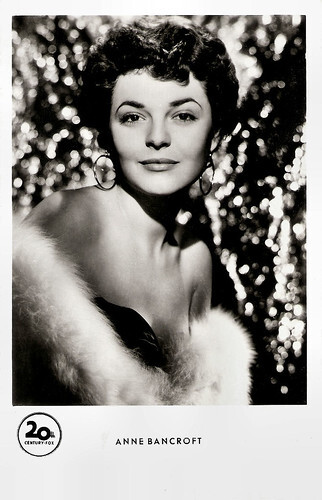
West-German postcard by Kunst und Bild, Berlin, no. A 1166. Photo: 20th Century Fox.
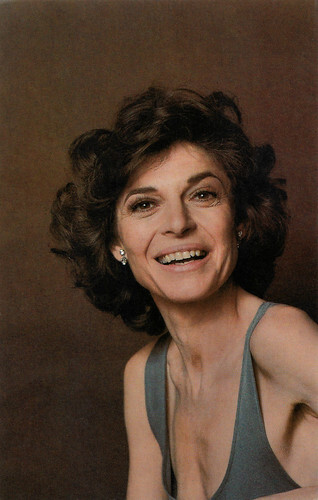
American postcard by Coral-Lee, Rancho Cordova, CA, no. Personality # 18, no. C32309. Photo: Douglas Kirkland. Caption: Anne Bancroft - Star of The Turning Point and other stage and cinematic successes. Ms. Bancroft is the wife of actor-writer-producer-comic Mel Brooks, October 1976.
To fulfil her dreams of becoming an accomplished stage performer
Anne Bancroft was born Anna Maria Louisa Italiano in The Bronx, New York, in 1931. She was the middle daughter of Michael Italiano, a dress pattern maker, and Mildred DiNapoli, a telephone operator.
She was trained at the AADA (American Academy of Dramatic Arts). As Anne Marno, she began her career on television in the 1950s. In 1952, she signed a contract with 20th Century Fox.
She was advised to change her surname for her debut, the Film Noir Don't Bother to Knock (Roy Ward Baker, 1952) with Richard Widmark and Marilyn Monroe . She chose Bancroft because she thought it was a dignified name.
After that, she played in the mediocre Sword and Sandal epic Demetrius and the Gladiators (Delmer Daves, 1954) starring Victor Mature , the Film Noir New York Confidential (Russell Rouse, 1955) starring Broderick Crawford and several B movies. By 1957 she grew dissatisfied with the scripts she was getting and after her contract with Fox expired, she left the film business.
Bancroft returned to New York where she enrolled in acting classes at HB Studios to 'unlearn' some of her film and TV techniques to fulfil her dreams of becoming an accomplished stage performer. In 1958 she won a Tony Award for her role in the play 'Two for the Seesaw' filmed in 1962. In 1960 she won another Tony for her role in 'The Miracle Worker' in 1959. Both plays were written by William Gibson.
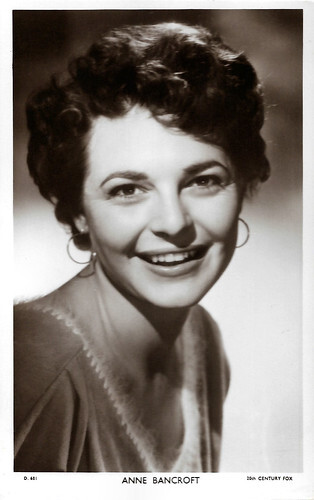
British postcard in the Picturegoer Series, London, no. D. 681. Photo: 20th Century Fox.
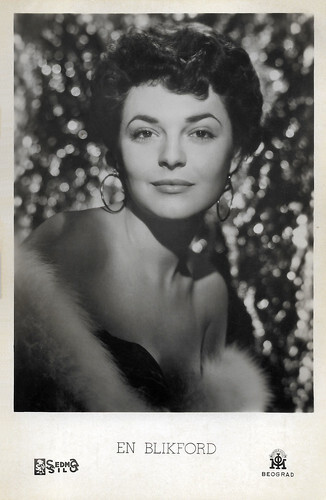
Yugoslavian postcard. Sedma Sila, Morava Film, Beograd (Belgrade). On this card, Bancroft's last name has turned into something only vaguely similar to her original name.
The ultimate 'older woman' who seduces her neighbour's boy
After these Broadway successes, Anne Bancroft returned to Hollywood, where she starred as Annie Sullivan in the film version of The Miracle Worker (Arthur Penn, 1962). She won an Oscar for it, but could not be at the presentation, as she was on Broadway at the time.
Bancroft went on to give acclaimed performances in The Pumpkin Eater (Jack Clayton, 1964) and The Slender Thread (Sydney Pollack, 1965) with Sidney Poitier . Her first husband, Martin May, was a lawyer from an oil-rich Texas family. In 1964, she married for the second time, this time to director Mel Brooks.
Her worldwide breakthrough was followed by The Graduate (Mike Nichols, 1967). In it, she played Mrs Robinson, the ultimate 'older woman', who seduces her neighbour's boy - the much younger Benjamin, played by Dustin Hoffman - into a sexual relationship. For this role, she was nominated for an Oscar. She gave birth to a son in 1972. She continued her career with such interesting films as Young Winston (Richard Attenborough, 1972), The Turning Point (Herbert Ross, 1977) with Shirley MacLaine , The Elephant Man (David Lynch, 1980) and To Be or Not to Be (Mel Brooks, 1983).
She made her directorial debut with the film Fatso (Anne Bancroft, 1980), starring Dom DeLuise. The film was financed by her husband's production company, Brooksfilm. She also started to make TV films, including Deep in My Heart (Anita W. Addison, 1999) for which she won an Emmy Award. Bancroft is one of the few people to have won 'The Triple Crown of Acting': an Oscar, a Tony and an Emmy. She is also one of the few actresses to win both an Oscar and a Tony for the same role. She was also Tony-nominated in 1978 for 'Golda', in which she played the title character, Golda Meir.
Anne Bancroft was again nominated for an Oscar for her roles in The Turning Point (Herbert Ross, 1977) and Agnes of God (Norman Jewison, 1985) with Jane Fonda . Her later career highlights include 84 Charing Cross Road (David Hugh Jones, 1987) as the American correspondent of Anthony Hopkins , Torch Song Trilogy (Paul Bogart, 1988) as the mother of Harvey Fierstein, and as one of the villagers in Waking Ned (Kirk Jones, 1998). In 2005, Anne Bancroft died of cancer in New York, at the age of 73. She is buried at the Kensico Cemetery in Valhalla, NY. Her final film was the animated feature Delgo (Marc F. Adler, Jason Maurer, 2008). It was released posthumously in 2008 and dedicated to her memory.
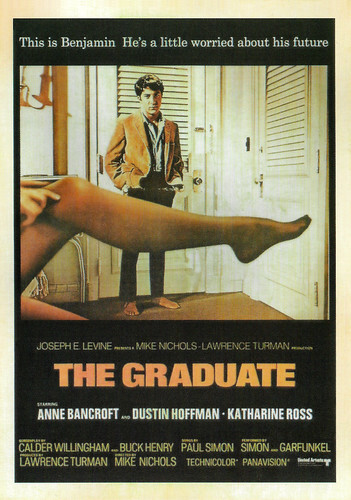
Vintage postcard. American poster by United Artists of The Graduate (Mike Nichols, 1967) with Dustin Hoffman and Anne Bancroft.
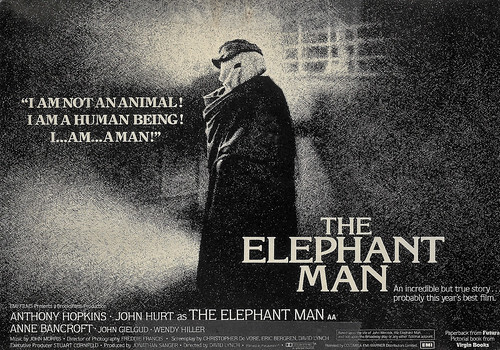
French postcard by Editions 'Humour à la Carte', Paris, no. A-C 91. British poster by EMI for The Elephant Man (David Lynch, 1980) with John Hurt, Anthony Hopkins and and Anne Bancroft.
Source: (IMDb), Wikipedia (Dutch) and .

West-German postcard by Kunst und Bild, Berlin, no. A 1166. Photo: 20th Century Fox.

American postcard by Coral-Lee, Rancho Cordova, CA, no. Personality # 18, no. C32309. Photo: Douglas Kirkland. Caption: Anne Bancroft - Star of The Turning Point and other stage and cinematic successes. Ms. Bancroft is the wife of actor-writer-producer-comic Mel Brooks, October 1976.
To fulfil her dreams of becoming an accomplished stage performer
Anne Bancroft was born Anna Maria Louisa Italiano in The Bronx, New York, in 1931. She was the middle daughter of Michael Italiano, a dress pattern maker, and Mildred DiNapoli, a telephone operator.
She was trained at the AADA (American Academy of Dramatic Arts). As Anne Marno, she began her career on television in the 1950s. In 1952, she signed a contract with 20th Century Fox.
She was advised to change her surname for her debut, the Film Noir Don't Bother to Knock (Roy Ward Baker, 1952) with Richard Widmark and Marilyn Monroe . She chose Bancroft because she thought it was a dignified name.
After that, she played in the mediocre Sword and Sandal epic Demetrius and the Gladiators (Delmer Daves, 1954) starring Victor Mature , the Film Noir New York Confidential (Russell Rouse, 1955) starring Broderick Crawford and several B movies. By 1957 she grew dissatisfied with the scripts she was getting and after her contract with Fox expired, she left the film business.
Bancroft returned to New York where she enrolled in acting classes at HB Studios to 'unlearn' some of her film and TV techniques to fulfil her dreams of becoming an accomplished stage performer. In 1958 she won a Tony Award for her role in the play 'Two for the Seesaw' filmed in 1962. In 1960 she won another Tony for her role in 'The Miracle Worker' in 1959. Both plays were written by William Gibson.

British postcard in the Picturegoer Series, London, no. D. 681. Photo: 20th Century Fox.

Yugoslavian postcard. Sedma Sila, Morava Film, Beograd (Belgrade). On this card, Bancroft's last name has turned into something only vaguely similar to her original name.
The ultimate 'older woman' who seduces her neighbour's boy
After these Broadway successes, Anne Bancroft returned to Hollywood, where she starred as Annie Sullivan in the film version of The Miracle Worker (Arthur Penn, 1962). She won an Oscar for it, but could not be at the presentation, as she was on Broadway at the time.
Bancroft went on to give acclaimed performances in The Pumpkin Eater (Jack Clayton, 1964) and The Slender Thread (Sydney Pollack, 1965) with Sidney Poitier . Her first husband, Martin May, was a lawyer from an oil-rich Texas family. In 1964, she married for the second time, this time to director Mel Brooks.
Her worldwide breakthrough was followed by The Graduate (Mike Nichols, 1967). In it, she played Mrs Robinson, the ultimate 'older woman', who seduces her neighbour's boy - the much younger Benjamin, played by Dustin Hoffman - into a sexual relationship. For this role, she was nominated for an Oscar. She gave birth to a son in 1972. She continued her career with such interesting films as Young Winston (Richard Attenborough, 1972), The Turning Point (Herbert Ross, 1977) with Shirley MacLaine , The Elephant Man (David Lynch, 1980) and To Be or Not to Be (Mel Brooks, 1983).
She made her directorial debut with the film Fatso (Anne Bancroft, 1980), starring Dom DeLuise. The film was financed by her husband's production company, Brooksfilm. She also started to make TV films, including Deep in My Heart (Anita W. Addison, 1999) for which she won an Emmy Award. Bancroft is one of the few people to have won 'The Triple Crown of Acting': an Oscar, a Tony and an Emmy. She is also one of the few actresses to win both an Oscar and a Tony for the same role. She was also Tony-nominated in 1978 for 'Golda', in which she played the title character, Golda Meir.
Anne Bancroft was again nominated for an Oscar for her roles in The Turning Point (Herbert Ross, 1977) and Agnes of God (Norman Jewison, 1985) with Jane Fonda . Her later career highlights include 84 Charing Cross Road (David Hugh Jones, 1987) as the American correspondent of Anthony Hopkins , Torch Song Trilogy (Paul Bogart, 1988) as the mother of Harvey Fierstein, and as one of the villagers in Waking Ned (Kirk Jones, 1998). In 2005, Anne Bancroft died of cancer in New York, at the age of 73. She is buried at the Kensico Cemetery in Valhalla, NY. Her final film was the animated feature Delgo (Marc F. Adler, Jason Maurer, 2008). It was released posthumously in 2008 and dedicated to her memory.

Vintage postcard. American poster by United Artists of The Graduate (Mike Nichols, 1967) with Dustin Hoffman and Anne Bancroft.

French postcard by Editions 'Humour à la Carte', Paris, no. A-C 91. British poster by EMI for The Elephant Man (David Lynch, 1980) with John Hurt, Anthony Hopkins and and Anne Bancroft.
Source: (IMDb), Wikipedia (Dutch) and .
Published on October 12, 2024 22:00
Paul van Yperen's Blog
- Paul van Yperen's profile
- 13 followers
Paul van Yperen isn't a Goodreads Author
(yet),
but they
do have a blog,
so here are some recent posts imported from
their feed.



